



 ByNOORIZZATYBINTEISHAK ProjectCoordinatorof CreatetheChangeProgramme
EditedbyRoseySimondsand VirginiaPontarolo
ByNOORIZZATYBINTEISHAK ProjectCoordinatorof CreatetheChangeProgramme
EditedbyRoseySimondsand VirginiaPontarolo
1.
f.
2.
a. Grants and Proposals
b. Effective Publicity Strategy
c. Outreach to Schools
3.
a. Workshop Planning
b. Key Activities: Introduction
c. Key Activities: You have a choice in how you react to a situation
d.
4.

CreateTheChangeToolkit 3
CONTENT
CREATE THE CHANGE (CTC) a. Foreword b. About Peace Child International c. Five Facts About CTC d. CTC Ripple Impact e. The TOOLKIT
Brief outline
CTC
of
OUTREACH
PLANNING:
PLANNING: PROGRAMME
Key
bullying
Activities: Resilience as a way of reacting to
EXECUTION: PROGRAMME a. Classroom Management b. The Role of Ambassadors c. Working With Teachers 5 6 7 8 9 10 11 19 22 25 28 30 35 40 46 47

CreateTheChangeToolkit 4
EVALUATION PROCESS
The Importance of Evaluation b. Quantitative and Qualitative Evaluation c. Create The Change: Our Process 6. LOGISTICAL MATTERS a. Getting CTC Facilitators b. Check list of Things To Do 7. FURTHER READINGS CONTENT 48 49 51 55 57 8. ANNEXES
5.
a.
Foreword
Welcome to the “Create the Change” toolkit.
We are delighted that Izzaty had the idea to produce this pack to show other groups, maybe in different countries, how to use the Create the Change programme. We will be very happy if you decide to do it with your school or group using the exercises and ideas but of course adapting it to suit your own needs.
I thought it might be worth stating why we wanted to develop a programme like this. For over ten years we have been running Ambassador programmes, training up young people to teach their peers about sustainability as well as leading workshops ourselves. When we were working in classes I often felt I would like to stop what we were doing and just focus on listening. We found that some of the children didn’t even realize that they didn’t know how to listen – nor did they have any idea of the effect this had on other people.
Everyone wants to be listened to, even if they don’t want to listen themselves, but you could train yourself to become a good listener.
Three years ago we worked with a school on a peace conference. They had a peer mentorship scheme in school for anti-bullying and wanted to collaborate with us to create an Ambassador programme in their school. We discussed with the young people about the programme and they showed concerns about having the same people who volunteer while others don’t as they feel that the opportunities are not for them. So as we were designing the project, we made sure that the group of ambassadors consisted of mixed abilities- the able with the under achievers and we found this worked well. Another concerned that was shared was how situations escalate and get out of hand in their inneer city school. So that influenced us to create a programme that aims to create choices to make a situation better than worse by involving young people to get produce the best ideas that would make the most impact in their school
We hope you will take on this programme. If you do please contact us at esd@peacechild.org and let us know how you get on or if you have any questions.
We have greatly enjoyed working on the project and hope you will too.
Good luck!


CreateTheChangeToolkit 5
Rosey Simonds Director of Create the Change programme
CreateTheChange
About Peace Child International
Foundedin1981,PeaceChildInternational(PCI)beganitsjourneyintheColdWarera, workingwithyoungpeopletoproduceamusicalbasedontheirwishtoendthenuclear stand-off between the USA and the USSR. Each production of the musical was rewrittenandcustomisedbyitscastandperformedtosell-outcrowds. Theperformances resulted in the first ever US-Soviet youth exchange in 1986, and its success (5,000 performances,within31countriesandinvolvingapproximately250,000youngpeople) allowedPCItoexpandintoanorganisationthathasbeenempoweringyouthforover30 years.
Our Mission - EmpoweringYoungPeople
How we operate - PeaceChildInternationalhasitsheadquartersinBuntingford,Herts (UK). There is a small professional management staff supported by an international youthvolunteerteam.Workinginequalpartnershiptheydevelopandrunprogrammes that further the aims of the organisation. They are in contact with a network of hundredsoflike-mindedbutautonomousyouthandNGOsaroundtheworld.
What we do - The charity works on three programmatic priorities –education, environment and enterprise -with a cross cutting theme of empowerment of young peoplerunningthroughallactivities.
OurcurrentProgrammesinclude:
Education: CreatetheChangeprogrammeinUKSchools
Environment: Weshowcaseandpromoteyoungentrepreneurswhohavestartedgreen businessenterprisescheme.
Enterprise: We are working on an EU sponsored project to research and share best practiceofyouthenterpriseandemployabilityschemesintheEU.
WewillberunningaJobCreationSummitinLondoninSeptember2013
WepromoteBetheChangeAcademieswheredisadvantagedyoutharegivenenterprise trainingandbusinessmanagement.
Every 2 years we run the World Youth Congress Series brining together activist youth fromallovertheworld.

CreateTheChangeToolkit 6
CreateTheChange
Five Facts About Create The Change

Fact 1:
It is a peer-to-peer education programme that explores essential communication skills such as speaking, listening and conflict resolution. These skills are explored through and interactive activities such as games, role-playing and drama to create an engaging and impactful experience. This programme covers two themes:
1. Dealing with reactions to bullying
2. Realising we have a choice to react in how we react to situations

Fact 4:
It is a three day ambassador programme that takes place in schools.


Fact 3:
It trains students aged 13 + to become Ambassadors. As Ambassadors, they conduct workshops and give performances for their younger peers in school. The selection of the Ambassadors is on a volunteer basis but we encourage schools to include students of mixed abilities including those who rarely volunteer along with their more able peers

Fact 5:
This programme fulfills PCI’s mission to empower young people. Participants develop confidence and communication skills as well as learning to take responsibility in school for dealing with prejudice, anger management and ways to combat bullying.

CreateTheChangeToolkit 7
Just like the waves in the sea, the impact of Create The Change is not only felt by the Students but it affects both Organisation (Peace Child international) and School Practices. Out Create The Change Report (Annex 1) showed the following:
CreateTheChange
The Ripple Impact




STUDENTS

In the first two years CTC reached out to approximately 1861 students.
50% of them felt that their confidence and listening skills had developed and improved.
76% of the 214 Ambassadors stated that they had increased their communication skills and confidence while 64% of them increased their empathy skills.
Young people who do not usually volunteer become more engaged in school activities
ORGANISATION
Increase in Monitoring and Evaluation Skills.
The tools and lessons from Create The Change were used in other educational programmes within the organization.
Able to adapt to different needs of schools without compromising expectations and impact of the programme.
Networking: Collaborating with other organisations to carry out the programme.
SCHOOL PRACTICE
Increased involvement of teachers in the students’ social development through the Teacher’s Pack which was designed by the organisation.
80% of teachers took part in the evaluation process and felt that it was effective having the pupils to carry out the workshops.
Schools are able to incorporate the programme in their school curriculum such as peer mentorship schemes and buddy systems.

CreateTheChangeToolkit 8
S T U D E N T S O R G A N I S A T I O N S C H O O L P R A C T I C E
CreateTheChange
The Toolkit
1. Purpose
Peace Child International believes that empowerment can happen EVERYWHERE and ANYWHERE. This Tool Kit will allow organisations or schools from different parts of the world to learn, understand and carry out CTC in their respective areas.
2. How to use the Tool Kit?
DOYOUWANTTO EMPOWERYOUNG PEOPLE?
This Tool Kit will help you step by step; from writing proposals and publicity to creating workshop plans and evaluation process. In this Tool Kit, the process are categorized into three sections: Planning, Execution and Evaluation.
PLANNING
PROPOSALS
PUBLICITY STRATEGY
WORKSHOP PLANNING
OUTREACH TO SCHOOLS
EXECUTION
CLASS ROOM MANAGEMENT
WORKING WITH TEACHERS
3. SYMBOLS IN THE TOOL KIT

Materials: CTC materials such as workshop plans or posters.

Resources: External Resources such as books or articles that are useful for the programme
EVALUATION
QUANTITATIVE EVALUATION
QUALITATIVE EVALUATION
COMBINED APPROACH
EVALUATION


Challenges: Setbacks that you may face in the programme.
Tips: Pointers that are used by us that could assist you with your programme.

CreateTheChangeToolkit 9
CreateTheChange
Themes of Create The Change
1. Dealing with bullying and building up resilience/confidence:
Students will explore the issues of bullying, observe the different reactions of dealing with bullies and the importance of resilience and confidence in holding your ground. The value of empathy will also be explored by the students as a way of standing up for others.
2. You have a choice in how you react to situations- looking at anger triggers. Students will explore their different anger triggers and observe their body language and the effect this has on other people. In addition, they will learn an important concept called “Stop, Look, Listen and Go Forward”, which will be practiced by students to see how to manage conflict in various situations. They will see how using “I” rather than “You” can improve a conflict situation.
Outline of Create The Change
ASchool Contract Agreement
B.3Day Ambassador Programme
Onceaschoolshowsinterestintheproject,organisationwillarrangeameetingwith them to confirm the theme of the programme, the number of students, important details of the school and sign the agreement contract. The agreement contract containsabreakdownofresponsibilitiesbetweenorganisation andschool.
Day 1: Training
Up to 20 Ambassadors will participate in a full day’s training where half will be trained to be facilitators and the other half devise two performances that produce keymessagesonthe selectedtheme.
Day 2: Rehearsal of scenes.
Ambassadorswillrehearsetheirfacilitationskillsandperformances.
Day 3:
Ambassadorswhoareactorswillpresenttheirperformancetotheiryoungerpeers. After the performance, the ambassadors who are facilitators will conduct the workshoptothesamerecipientaudience.
C.FollowU Evaluation
Organisationwillreturnandvisiteachclassfor15minutestoconductfollowup evaluationswith recipientsstudentsoftheprogramme andAmbassadors. Alternatively,teacherscouldconductevaluatiosn followingtheguidelinesandsent thefindingsbacktotheorganisation.

CreateTheChangeToolkit 10
Planning:Outreach Grants and Proposals
Your first step in carrying out Create The Change is to find financial sources to be responsible for the cost of the programme. If you are a non-profit organisation, this section will be useful for you! It will briefly talk about grants, where to find them and also tips in creating an effective proposal!
Which Grant Should You Apply To?
Benefits:
Solve Financial Predicament
A good marketing strategy if the grant is from a prestigious organisation.

GRANT:
A grant is an amount of money, given by an organisation for a specific purpose.
Step 1: Understanding your organisation and the programme’s objective.
Step 2: Research on the organisation that is providing the grant. Focus on the objectives and aims of the grant.
Step 3: Analyze how your programme or organisation meets the grant’s ELIGIBILITY CRITERIA. These are a set of rules that demonstrate who can and can’t apply for funding. If you do not fit the criteria, do not apply. These steps are essential in effectively identifying the appropriate grant scheme for the programme. In Peace Child, we received fund from the Paul Hamlyn Foundation as it aims to sponsor programme that encourages listening and speaking skills. This coincides with the programme’s objectives: increasing communication skills. In addition, Peace Child was able to meet most of the criteria such as a participative programme for minorities or under privileged students in schools.

Where To Find Grants?
Understanding the Priorities of Grants:
Funders have their own priorities about the sort of projects they want to support. It all depends upon on their overall aims and objectives. Projects that will PRODUCE RESULTS to further the Grant’s aims will therefore be of most interest to the funders.. If we understand what our funders want to achieve with their money, we will be saving time and effort in finding a suitable grant for the programme.

Resources:
1. Whaley,S. (2007) FundraisingFora CommunityProject:HowTo ResearchGrantsandSecure Financingforlocalgroups andprojectsintheUK.How to books: UK

CreateTheChangeToolkit 11
Local Government Agency Government Agencies offer a wide range of grants such as social care and education. Charitable trusts and foundations Charitable and community foundations who administer charitable funding . Local Development Agencies Local Development Agencies in the voluntary sector operate grant schemes on behalf of local authorities or other funding partnership. In addition, they will also have access to funding databases, listing hundreds of grant-making bodies and trusts.

Planning:Outreach Grants and Proposals
Tips for finding a suitable grant for Create The Change
Tip 1: When you are researching for grants, research funding bodies that target youths and education. These funding bodies may have similar objectives and aims as Create The Change.
Tip 2: Always read the Criteria for Eligibility. Does your organisation and programme fit with the grant’s criteria of eligibility? If no, do not apply for the grant. This will help you to save time and effort in finding potential grants instead of wasting your time in writing forms that you are not eligible for.
Tip 3: Look out for Funders who would like to fund projects that will help to increase the communication skills of youths such as listening and speaking skills, empower young people through participation, increase youth’s leadership skills and encourage arts for social development. These are possible themes for which Create The Change could be eligible.
Tip 4: Research groups that are similar to Create the Change and have received funds from funding bodies. This will be a great opportunity for you to understand the procedures and gain more tips on securing grants.
Tip 5: Networking in conferences or seminars that are about youth and education. This will be a great chance for you to put across the benefits of your project. Furthermore, it is a great moment for you to talk about Create The Change with people who may have connections and knowledge about suitable funding bodies for the programme..

CreateTheChangeToolkit 12
Planning:Outreach Grants and Proposals
Creating an Effective Proposal
The next step after finding a suitable grant scheme for the programme is to read the proposal form given by the funder. It is important to read the form and understand the different information that a funder needs to take in consideration when determining whether to award the grant. Here are some tips for you to consider when writing an effective proposal!
1. Introduction of Your Project
Be specific! Give detailed description of the aims and objectives of the project and how the grant money will be spent.
The more specific you are, the clearer the picture your funder will have about the programme.

Add your description of the work for which you require funding:
BE SPECIFIC!


An innovative Conflict and Communication peer-to-peer education programme, training "ambassadors" to teach their peers speaking, listening and conflict resolution skills using games, exercises & drama. The project will bring together students who struggle in school anddonotusuallyparticipateinthecommunity,withtheirhigherachievingpeers.
Wewillofferschoolstwostrandstotheprogramme:
AnAmbassadorProgrammewithYear10
Agroupofstudentsineachschoolwillreceiveadayoftrainingindeliveringworkshopson communication and conflict. They will learn games and exercises, develop their presentation and facilitation skills, as well as increase knowledge of their own communication style and responses to conflict. We will then support the group as they create their own workshops from the menu of ideas we have provided and their own innovations.Theywillfacilitatethesewithyoungerstudentsaged10+.

CreateTheChangeToolkit 13
Figure 1: Create The Change Proposal (Description of Programme).
Planning:Outreach Grants and Proposals
2. Why is Your Project Needed?
Funders want to know the reason for the programme. Is there a demand for it? What are the issues that are faced by the community that result in the need for the programme?
Before writing the proposal, conduct research and surveys in school to determine the problems or issues faced by the community. This will provide credible evidence and a baseline data about the issues that the programme aims to transform positively.
Collect your evidence, research and other information together and summarize it on the application form.
How do you know the work is needed?
Firstly,ourexperienceofdoingpeereducationworkinUKschoolsoverthepastsevenyears hasshownusthatthisworkisdesperatelyneededforbothstudentsandteachers.Teachers, school administrators and students themselves tell us that a lack of listening and communication skills in group situations are a barrier to learning: they are frustrated and exhaustedbytheconstantneedtorepeatthingstomakestudentslisten.Whatisneededisa new medium of communication that will equip students to communicate better with each other, their teachers and the school authorities, to enhance their self-esteem and reduce incidents of violence in the school. We believe it is good to bring together able students alongside those who can be termed as “under achievers.” Acquiring good communication skills are essential skills for young people looking for employment. When implemented effectively, the results benefit whole school communities with a more responsive learning environment.
Secondly, one only needs to look at government initiatives in schools, to see that there is a massive need for this kind of work. Our programme would contribute to Community Cohesion, Social and Emotional Aspects of Learning (SEAL) and Personal Learning and ThinkingSkills(PELTS).ItwouldalsofocusonLeadershipskills,somethingwhichschoolsare increasinglylookingtoprovide.

CreateTheChangeToolkit 14
Figure 2: Create The Change Proposal (Importance of Programme)
Planning:Outreach Grants and Proposal
3. Timeline of Project: Start, Completion and Milestones
A Timeline shows funders that you have planned and organized your time to achieve your desired outcome.
Milestones – are important as it can help you to monitor how your project is progressing. If the work begins to slip behind schedule, a milestone will bring this to your attention earlier, enabling you to take the necessary action to get it back on track.
It is advisable that when working out your start, end and milestone dates, the dates should be realistic, achievable and flexible. This is because unforeseen circumstances could happen and affect the timeline. If the timeline is too rigid, this could be a disadvantage in achieving the outcome on completion day.
Founders will appreciate it when you identify possible risks that could arise during the process as this shows that you are prepared to face the problems and solve them.
Example of Time Line
Realistic Flexible

CreateTheChangeToolkit 15
S/N Month Goals Description Duration 1. January 1.Conceptualize andconfirm structureof programme Finalizeobjectives,goalsand targetcommunity. Researchontarget communityandtheirneeds. 1month 2. February 1.Getfundingfor theprogramme ResearchonGrants WriteandSubmitProposals 2months
Achievable Achievable
Planning:Outreach Grants and Proposal
4. Outputs of Create The Change
Outputs are targets that your project has to achieve.
Indicating the outputs of the programme will allow funders to know how their money and involvement will be used and achieve specific goals.
To create each output target, SMART goals are used. SMART goals allow you to monitor and measure the outcome of the programme quantitatively during the evaluation process.
SMART Goals
Specific:
Agoalthatis specific,defined anddetailedwill haveagreater chanceofbeing accomplished thanageneral goal.
Measurable:
Ameasurablegoal allowsyoutokeep trackofyour progresstowards reachingyourgoals.
Tocreatea measurablegoal, providequantityin yourgoalssuchas, “Wewillbringthe programmeto3 schools.
Output Example:
Attainable:
Agoalthatis attainableshould berealisticbut challengingatthe sametime.
Itshouldbe achievableinline withthelimited resourcesthatyou have.
We will work with 40 schools in Hertfordshire, Sussex, Bedford and London over 3 years where we will train 10-20 ambassadors in each school from Year
9. In each school, at least 100 additional pupils will both watch the performance and be involved in the workshop. Thus a total of 4,400 pupils will participate in the programme at the end of 3 years To achieve this, we will work with 13 to 14 schools each year.
Relevant
Makesureeach goalisconsistent withothergoals youhave establishedand fitswithyour immediateand long-rangeplans.
Timebound
Giveyourselftimeto achieveyourgoals.
Ithastoberealistic butchallengesyouto achieveyourgoal withinthetime framegiven
Settingsmall deadlinesduring yourproject will allowyoutrackyour progress.
SPECIFIC MEASUREABLE ATTAINABLE TIMEBOUND RELEVANTTOPROJECT

CreateTheChangeToolkit 16
Planning:Outreach Grants and Proposal
5. Setting Outcomes for Create The Change
An Outcome is the anticipated effect or impact that the project will have upon the target audience (pupils, teachers, school ethos) as well as the local community.
The difference between Outputs and Outcomes is that Outcomes are less specific but look at the wider impacts such as a decrease in bullying in the school or the strengthening cohesiveness of the school community.
Outcomes are important to the funders as they indicate the wider issues that the project is trying to solve while it is your outputs that will assist you to achieve this.
What do you aim to achieve? - please specify intended outcomes at the level of the participants, the applicant organisation and, ideally, the wider sector
Outcomes for the Participants:
Improved Listening & Presentation skills: In both strands, we aim to equip the students with listening skills, presentation skills, increased self-confidence and self-esteem plus an insight into their own responses to conflict, including the choices they have to make if they are to deal with it constructively.
Improved Leadership skills: The Ambassador programme will develop leadership skills by helping young people to become effective peer educators.
Empowerment: We also aim to improve the academic attitudes and performance of students who struggle in mainstream classes by enabling them to participate as equals with higher performing students in these exercises.
Outcomes for PCI:
We have done a lot of work with schools over the years. We have seen the need for improving student’s listening skills in order to get any ideas across, and to develop their often very limited presentation and speaking skills. Creating this new programme will provide us an opportunity to try out new training ideas, deepen our experience and assess, more critically, the training methodologies we employ.
Outcomes for the wider sector:
We hope to influence others in the sector by showing the power of youth leadership and peer education in this particular area of dealing with conflict, listening and participation. We shall share and showcase these methodologies to our international network by leading workshops at conferences, like our own World Youth Congress, to be held in Istanbul in August 2010.

CreateTheChangeToolkit 17
Figure 4: Create The Change Proposal (Possible Outcomes)
Planning:Outreach Grants and Proposal
6. Beneficiaries of Create The Change
As funders have their own objectives and aims as to whom they want to support, it is important to indicate your target beneficiaries as this will influence the funders’ decision.
You could indicate the demographic of your target beneficiary in terms of age, social status, behavioral standards, family background and other descriptions. It is also important to indicate the number of people that you would like to impact from the project.
You should also justify how the beneficiary will benefit from the project. This will allow funders to understand the importance of the project for the beneficiary. Who will benefit from your proposed work (if they live in a particular area or areas, please say which)? Number and age of beneficiaries?
We will work with 40 schools over 3 years, training 10-20 ambassadors in each and/or a group of 12 year nines for the drama component. Thus we will directly work with 400 + Ambassadors. In each school at least 100 additional pupils will receive performances or workshops from the students. Thus approximately 4,400 pupils will be affected. There would also be opportunities for others such as teachers/parents/siblings.
The programme will benefit these people on a number of different levels:
Level One
Year ten students who become Ambassadors will include students of varying abilities - many of whom have not taken an active part in the school community before or ever volunteered. They will do the training and facilitate their own workshops with Level Three beneficiaries.
Level Two
Year nine students who will create pieces of interactive ‘Forum Theatre’, in either an offtimetable PSHE or Citizenship day or over a period of weeks. This experience will teach listening, storytelling and performing skills, building self-confidence and the ability to work in a team.
Level Three
Students in years seven and eight, who will receive Conflict and Communication training from the peer Ambassadors, or watch and participate in the Forum Theatre performances (which would be suited to an assembly format). This can also extend to year six students in feeder primary schools, creating the additional benefit of introducing these students to older members of their senior school community, helping with the transition between primary and secondary schools.

CreateTheChangeToolkit 18
Figure 5: Create The Change Proposal (Possible Beneficiaries)
Planning:Outreach Grants and Proposal
7. Project Cost Outline
The reason you are applying for funding is because there are costs involved in your project. Due to this, it is important to create a detailed project outline for the funders.
When considering the different costs of your project, it is important to justify the amount that you have indicated to the funder. Funders will not expect you to go for the cheapest, but they will expect you to go for the right cost for your project. A higher cost providing better quality product or services that isn’t available elsewhere, is a valid reason for not choosing the cheapest.
Create the Project Cost Outline in a table form that is organized and clear. Put them in various categories such as transportation, writing materials or printing services.
Always double-check your figures and addition when adding up the total cost of the project. It is advisable to get someone else involved to double check the project cost outline.

CreateTheChangeToolkit 19
Figure 6: Create The Change Proposal (Cost Outline)
Exact breakdown of how PHF money would be spent: Year 1 Description Amount Advertising for staff post £350 Salary for a new Conflict-Communication staff member at Peace Child to lead the project, select the schools and train each group of Ambassadors £20,000 £20,000 Equipment, resources including books and manuals. A resource library so that the staff and Ambassadors have access to the best available teaching ideas. Also includes printouts, posters, flyers etc. website management £2,000 Support Administration including PCI volunteer to arrange bookings and assist in trainings @ £5,000 £5,000 Travel expenses to reach schools: up to 8 x visits to 12 schools@ £25 per trip £2,400 Expert to assist with evaluation process TOTAL: £1,000 £30,750 Year 2 Description Amount Salary for a new Conflict-Communication staff member £20,000 Equipment and resources £1,000 Support Administration £5,000 Travel expenses to reach schools: up to 8 x visits to 15 schools@ £25 per trip £3,000 TOTAL: £29,000 TOTAL for 2 years $59,750
Planning:Outreach
Effective Publicity Strategy
To make Create The Change successful, we need schools to be involved in our programme. Getting schools to be involved can be challenging. It is important to have a plan to promote the programme to the schools and encourage them to be interested in participating in it. The first step is to create an effective publicity strategy!
1. First step: Answering the questions
The first step of creating a Publicity Strategy is to answer the following questions:
A. What is your goal and objective for this strategy?
B. Who are you reaching out to?
C. What do you want them to know?
D. What do you want them to do?
These questions will help you create goals and objectives for your strategy. It will allow you to understand the end results that you have to achieve when thinking about the different Tactics to publicize the programme.
Example:CreateTheChange
Questions
A.Whatisyourgoaland objectiveforthisstrategy?
B.Whoareyoureachingout to?
C.Whatdoyouwantthem toknow?
D.Whatdoyouwantthem todo?

Answers
Thepurposeofthisstrategyistoget40schoolstobeparticipate inCreatetheChangeattheendof3years. Eachyear,wewouldlike10to14schoolstobepartofthe programme.
Aswewanttoworkinschools,wewanttoreachouttopeoplein theeducationsectorsuchasteachersandprincipal.
Wewantthemtoknowaboutthe3daysAmbassadorprogramme wherewewilltrain20studentstofacilitateworkshopsand performfortheiryoungerpeers. Inaddition,wewantthemto understandthebenefitsoftheprogrammefortheirstudentssuch asanincreaseinconfidence,communicationskills,anger managementandabilitytoempathisewithothers.
Wewantthemtobeinterested,beinvolvedintheprogramme anddevelopnewskills.
CreateTheChangeToolkit 20
Planning:Outreach
Effective Publicity Strategy
2. Second step: Tactics
The second step of creating a Publicity Strategy is to think of different tactics to publicize the programme such as:
1. Design: Posters, Leaflets or Newsletter
2. Writing: Press Releases, Advertisement or Newspaper article
3. Networking: Going straight to schools, Education Conferences or Public Speaking
When thinking of tactics to publicize the programme, it is important to think of the following questions:
A. What are the resources that I have in terms of people, time skills, equipment and money?
Looking at your resources and playing to your strengths is key to a publicity strategy. If you have a graphic designer in your organisation, it will be useful to have themn design impactful posters for the programme. But if you don’t have enough man-power to got to 100 schools to promote the programme in two weeks, then it will be a waste of time and effort. Always think of an effective way to mange your resources!
B. When is the right time to do the publicity?
If your tactic is to create an event to bring your future participants together you will need to plan it in advance. Be realistic in giving the time to plan the event. If you do not have enough time, then play a do a time- efficient strategy such as sending out e-mails.

Tips on Creating a Flyer
1. Relate it to your target audience.
2. Make it short, punchy and easy to understand.
3. Include a brief outline about the programme.
4. Testimonials are great if you have done the project before.
5. Always include the benefits of the programme.


CreateTheChangeToolkit 21
A specia project from Peace Ch ldInternationa (PCI) sponsored by the Pau Ham yn Foundaton Would you like to he p your pup ls: Ga n confidence? Improve their communication skils? Resove conficts better? Work w th d fferent people? Embed SEAL and Pupil Voice? If youanswered yes toany of the above then we could be just what you need C eatetheChange has beenrunning or over ayearand ahaf and hassuccessfu lycompleted the programmein h H t d h B d d h d C b dg h What tinvo ves Th s programmebenefts yourpupi s by Deve op ngcommun cationsk ls He p ngpup stounderstand angertrggers Bu d ngup pup resi ence againstbu yng Expor nghowtheyworkwth d feren groups o peope Gvng them he oppor un ty o each each other Ras gse festee D p g d hip k l He p ngthem rea sethehugey mpor ant parttheyplay n society Ft ng n o theSEALcurrcu um in reso vingconf cte fec vey and a ry Add g th d t y PSHE/Citi hip i There are a l m tednumber of FREE workshops ava labe first come f rst served Dont de ay g ve Roseya cal today on 01763 274459 or emai esd@peacechid org comes rom young peop e and here ore f t y f y g t g k d o s up and ten than f t comesf om a teache /ano her adu t (Teacher) Pup ) P p ) Dscuss withus hecommunca onareas thatyourpup ls would lketoimprove S tt ty t A b d f y 9 b We run a 1-day Conf ct& CommuncationTran ng workshop ortheAmbassadors We tra nthem to deiver an assemby and workshop o youngerpup sw h d ama gamesand exercses W pp y th h y i d! Wecome backata aterstage for a1hour practce sess on wththeAmbassadors Th A b d d i th k- h p th pp t d f db k Weho d a o owup sess on where heAmbassadors eva ua e heprogramme ssuccess!
CreateTheChangeFlyer . SeeIntroductionPack
Planning:Outreach Outreach to School
What happens when a school is interested in the project?
When a school is interested in the programme, they may contact you through e-mail or a phone call. Set up an appointment to meet them. If the school is unavailable to meet, communicate through e-mails or phone calls. Below is the checklist of things that you need to find out two weeks before the programme either in person or through e mail.
First Meeting with the School
During the appointment with the school, the organisation and the school has to discuss:
The theme of the programme.
The date of the programme.
The requirements needed from the school.
The date for evaluation
In addition, the organisation has to prepare an Outreach Pack and Create The Change Agreement Contract
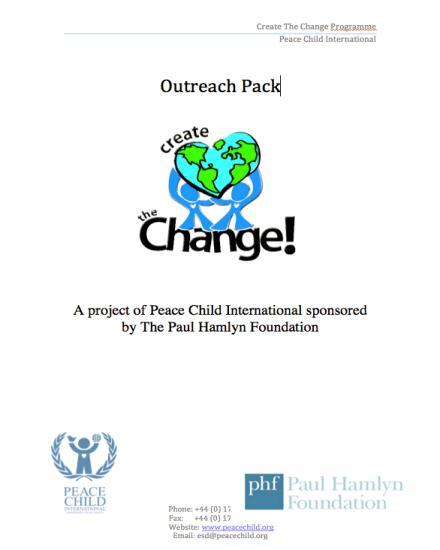
Create The Change: Outreach Pack
It is important to provide an outreach pack for each school that is interested in the programme. This pack will allow them to have a better understanding about the programme and what their role would be.
The contents of the pack are:
1. About the Organisation
2. About Create The Change
3. The Role of the School
4. Sample workshop plans
Refer to Annex 2: CTC Outreach Pack
Create The Change: Agreement Contract
An agreement contract is created to ensure that both organisation and school understand their responsibilities in carrying out the programme which includes the execution and evaluation phase.
Both representative of organisation and school have to be present to agree on the decision that has been made and sign the contract.
See Introduction Pack CTC Agreement Contract

CreateTheChangeToolkit 22
Planning:Outreach Outreach to School
Two Weeks before the Programme
It is important to continue communicating with the school after the appointment. Two weeks before the programme the organisation will:
Send all edited workshop plans according to the school needs.
Letter to Ambassadors
Letter to Teachers Involved
Teacher’s Pack
Communication Skills Questionnaire
Edited Workshop Plans
It is considerate to send them the workshop plans in advance so that schools will approve the activities of the workshop and the running of the programme.
Teacher’s Pack
The Teacher’s Pack contains follow up activities that the school may be interested in carrying out as a tool of reinforcing the key messages of the programme.
Refer to Annex 5: Teacher Pack

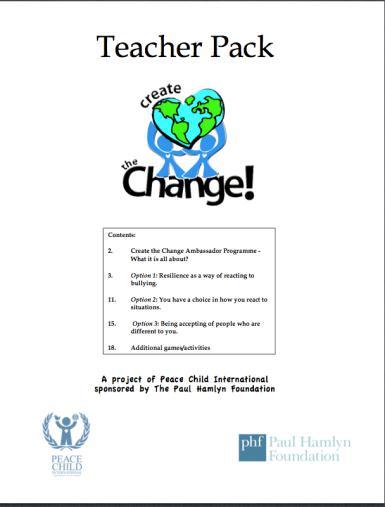
Letters to Ambassador and Teachers
The letters to Ambassadors and Teachers is to inform them about their roles and expectations in the programme.
Refer to Annex 4: Letters to Ambassadors/ Teachers
Communication Skills Questionnaire
The questionnaire is sent to school for printing if the organisation does not have the resources to print a large amount for the school.
Refer to Annex 3-A: My Communication Skills
CreateTheChangeToolkit 23
Planning:Programme Workshop Planning
The purpose of this pack is to bring Create The Change to different communities, cultures and mindsets. Due to this, we believe that the workshop plans that were done by Peace Child can be modified according to the needs of the groups you are working with. This section will provide you with a framework that you could use while planning the different types of workshops: Ambassador Training Workshops, Actor Ambassador Workshops and Ambassador Facilitator Workshop and Workshop for Recipient Younger Peers.
Workshop Plan Framework
Phase Definitions
Introduction
Pre-Text
The purpose of the introductngion is to introduce the programme, organisation and students as wellasestablishingground rulesfortheworkshop.
Anintroductionphasemayconsistofthefollowingdepending onwhich typeof workshopyouare planning:
1. IntroductionofOrganisationandprogramme.
2. Icebreaker/Namegame
3. Pre-EvaluationformforParticipants.
4. Establishing GroundRules.
Pre- Text can be used as a stimulus or “ launching- pad” to ignite the interest of the participants about the theme that they will be exploring. As mentioned in Cecily O’neill’ s Drama Worlds: A Framework for Process Drama, the Pre-Text creates a bridge for participant to be in the “ Drama World”.ThisisessentialforCreateTheChangeasitusesdramaactivitiestoexplorethethemes.
TThe Pre- Text should provide an introduction of the activity that encourages the participants to explorationandtransformation.Itshouldalsosuggesttherolesandtasksthattheparticipantshave tododuringtheworkshop.
Pre-textcouldbedonethroughthefollowingmediums:
1. Digital:Videos,VoiceRecording,MusicandSounds
2. Drama:Hot-Seating,Improvisation,PoemsorObjects.
3. Games/Exercises:DogandBoneorFollowingtheLeader

CreateTheChangeToolkit 25
Planning:Programme Workshop Planning
Phase Definitions
Main Activities
The objectives of the Main Activities are to achieve the goals of the workshop and allow participantstoexplore,practiceandtransformtheissuesthatareraisedfromthetheme.
Whenchoosinganactivity,youshouldaskyourselfthefollowingquestions?
1. Doesitmeettheobjectivesoftheworkshop?
The activity should be concise and meet at least one of the objectives. To meet all the objectives, you should select 2 to 3 activities. If it is not concise and doesnot meet the objective, participants may feel confused about the purpose of the activity and its connectionwiththetheme.
2. Isitsafefortheparticipants?
The activity should encourage safe space and allow participants to be comfortable during theprocess.Therearetwowaystomakeasafespace:
Removal of physical danger: Be in a space that is safe for the participants to do the workshop. Remove any dangerous items that could potentially hurt the participantssuchasscissors,knivesorhotdrinksfromthespace.
One Step Removed: Thecontentoftheactivityshould notbeadirectre-creation ofthelifeeventofanyonepresent.Itissaferthanapersonallevelofworkbecause the distance allows participants to acknowledge their connections to the material atapacetheycanregulatethemselvesandbecomfortable.Iftheactivitydiscusses sensitive issues, it will be useful to use this method as a way to create a suitably comfortablesafespacetoexploretheissues.Nooneshouldbeencouragedtoshare personaldetails.
3. Useoftime
Theschoolmayonlyallowyouashortertimethantheoneyourequested.Soyouneed to be mindful about how long eachactivity takesand whatits impact is.Inthis wayif you have to shorten a workshop you have identified which are the vital points to get across.
4. Doparticipantsfeeltheyareenabledtomakedecisions?
Create the Change is a programme that aims to provide ownership to the participants. Providing ownership motivates students to be part of the programme as they have the power to create choices and to voice their opinions.
Whendecidingontheactivity,youcanquestionthefollowing:
I. Doesitallowparticipantstomakedecisions?
II. Doesitallowthemtopresenttheirideas?
III. Doesitallowparticipantstounderstandkeymessages?

CreateTheChangeToolkit 26
Planning:Workshop Workshop Planning
Phase Definitions
Reflection
Thereflectionphaseconsistsofactivitiesthatallowparticipantstoreflectontheirlearning.Italso allowsthemtheopportunitytopracticethekeymessagesindifferentsituations.
Thereflectionphasealsoofferstheparticipantscontroloverwhattheywanttosayandwhatthey wish to withhold. Furthermore, it should reinforce the learning that has been done in the workshop.
ExamplesofReflectionActivities:
1. LetterWriting
2. Hot-Seating
3. MakingPosterorsimplecardwithkeyfacts.
Organising Your Workshop Plan
When writing a workshop plan, it should be clear, specific and easy to understand. The quality of the workshop plan should be good enough to be picked up by any facilitator, and they should be carry out the activities without needing any further explanations by the organisation. To create a detailed workshop plan the following subheadings are useful:
Activity Description Objectives Duration Facilitator Materials
Name of Activity
Name should relate to activity so that the facilitator will be able to remember it.

Describe how the activity should be carried out.
Take a step by step approach to explain the activity.
Resource:
1. Nicholson, H. (2005). AppliedDrama:The GiftofTheatre.Theatre Performance Practice: UK
State the goals of the activities.
Be specific so that the facilitators will be able to measure the impact of the activity.
The length of the activity being carried out.
This states who is leading the activity.
This is important when there is more than one facilitator running the workshop.
This states the different materials needed for the activity.

CreateTheChangeToolkit 27
Planning:Workshop
Key Activities
Activities play an important role during workshop planning. As the workshops are thematic, each themed workshop should have different Key Activities to achieve their respective objectives. In this section, we will touch on:
Introduction Activities: Activities that are used in the beginning of all theme workshops
“You have a Choice in how you React Workshop”: Key Activities
“Resilience as a way of Reacting to Bullying Workshop”: Key Activities
Introduction Activities
Introduction activities are the same in each themed workshop to assure consistency throughout the programme despite the following activities which relate to the different themes. The objectives of the introduction activities are:
To inform participants about the programme and their roles.
To create a comfortable space.
To carry out a pre-evaluation form.

CreateTheChangeToolkit 28
Activities Objectives Duration Introduction To introduce Peace Child and the objectives of the programme. 10mins Ice Breaker/Self Introduction To create a safe and fun place for the participants to be comfortable. 10mins Self-Assessment:My Communication Skills To allow participants to reflect on their communication skills. For Peace Child’s evaluation purposes. 7-10mins What makes a good presentation? To allow participants to explore different ways to create a good presentation. 10mins
Introduction Activity Plan
Planning:Workshop
Key Activities
Introduction Activities
1. The Introduction:
Introduce organisation
Introduce the programme.
Brief outline of the day.
2. Ice Breaker: Splat
“
Get the participants into a circle.
There will be a person in the middle who will be “splatting” the people in the circle.
If one person in the circle is being “splat”, they have to squat down while the two people at their side have to “splat” each other as fast as possible.
The one who is being “splat” first will be out of the game.
3. Self Assesment: My Communication Skills
1. Discuss with participants the different kinds of communication skills. Example: Listening, being confident and empathy.
2. Give each participant a “My Communication Skills” form.
3. Invite participants to think about their communication skills while filling the form.
4. When they have finished, gather them into a circle.
5. Each participant will tell their name and one communication skill that they want to improve
Example:
“My name is Jeremy and I want to improve my listening skills.
SPLAT!



4. What makes a Good Presentation?
Discuss with participants the different skills that are needed to make a good presentation.
Write all their suggestions on a flip chart.
Brainstorm different techniques.
CreateTheChangeToolkit 29
Planning:Workshop
Key Activities
You Have A Choice In How You React in a Situation: Key Activities
1. Objective of workshop
To explore choices and consequences.
To allow students to explore different conflict resolution strategies.
To make students realize that they can make the choice to react positively or negatively in a conflict situation.
2. Key Activities
5 Things That Makes Me Angry Activity.
Stop Look Listen and Go Forward Activity
I VS You Role Play
Reflection Poster
You Have A Choice: Key Activities
Refer to Annex 7: You Have A Choice Workshop Plan





CreateTheChangeToolkit 30
Activities Objectives Duration 5 Things That Makes Me Angry activity To allow participants to understand personal anger triggers and how to resolve them. 10mins Stop Look Listen and Go Forward activity To equip participants with a strategy that could be used in a conflict resolution. 15mins “I” vs. “You” Role Play To equip participants with a strategy that could be used in a conflict resolution. 15mins Poster Reflection To allow participants to reflect on the activities that they have done. 10mins
YOU HAVE A CHOICE!
Planning:Workshop
Key Activities
You Have A Choice In How You React to a situation: Key Activities
1. Anger Triggers: 5 Things That Makes Me Angry
Discuss with participants about anger triggers.
Each participant will be given an A4 size paper. They have to draw the outline of their hand on the paper.
Each participant has to write 5 anger triggers; 1 anger trigger for each finger.
When finished, ask the participants to find a partner. They are to share their anger triggers.
In pairs, they have to identify those anger triggers that can be controlled and those that can’t. Example:
Control: My sister sings loudly in her room while I am studying in my room. I feel frustrated as it disrupts my concentration. I can control the situation by going to her to resolve the situation positively.
Can’t be Controlled: I have been waiting for the bus for 30 minutes. I feel angry because I will be late for school. Even so, I can’t control the situation.
After identifying the angers, in pairs, they have to advice each other how to resolve their anger triggers that can be controlled.
Each pair is to share one anger trigger that can be controlled and one that cant to the group. They then share the solution for the anger trigger that can be controlled.

Tips:
1. Before carrying out the activity, ask them questions about anger triggers. The purpose is to allow participants to define the meaning of anger triggers and its relation to them.
2. Provide examples of anger triggers that can be and those that can’t be controlled to give a clearer explanation to the participants
3. If participants are unsure how to create solutions for anger triggers, inform them about the three steps in controlling their anger triggers
Identify your anger triggers
Consider what changes can be made to prevent this anger
Explore why these situations or people are so often associated with your anger triggers.
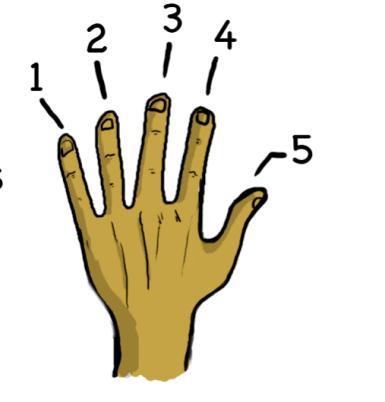

CreateTheChangeToolkit 31
5 Anger Triggers!
Planning:Workshop Key
Activities
You Have A Choice In How You React in Situation: Key Activities
2. Stop Look Listen and Go Forward: A conflict management strategy
Present and explain “Stop Look Listen and Go Forward” strategy through the sign boards provided.
Facilitators will role- play a conflict situation.
Ask participants how the strategy could work in that situation.
Facilitators will re-play the scene with their suggestions.
Ask two volunteers from the participants to think of another conflict situation and perform in front of the group.
After the volunteers perform their conflict situation, the group could suggest ideas using the strategy to solve the situation.
Volunteers re-play the scene with the suggestions.
Facilitator to wrap up the activity.








Whatisgoingonhere?
Before escalating the situation, stop and evaluate the situation.

Materials
1. “Stop, Look, Listen and Go Forward” Posters.
Refer to Annex 1-B: “You have A Choice” Materials.
Howaretheybehaving?
Look at each others’ behaviour and body language.
Whataretheirdifferentpointsofviews?
Listen to both sides of the story. Instead of speaking over each other, listen and understand each other’s perspective.
Howdowecompromiseandresolvethesituation?
Discuss and work together towards creating a positive outcome from the situation. Suggest solutions that may prevent the conflict situation from happening again.

CreateTheChangeToolkit 32
STOP LOOK
LISTEN GO FORWARD
Planning:Workshop
Key Activities
You Have A Choice In How You React To a Situation: Key Activities
3. I Versus You: Communication Strategy when solving conflict
Two facilitators will perform a scene about a pair of siblings blaming each other.
Discuss with participants what are the problems in the scene focusing on communication.
Ask them if they notice how they are blaming each other.
Inform them the strategy of using “I” statements rather than “You” is a good way to get your feelings across without threatening the other person.
Tell them about the three steps of communicating while using “I” statements. When this happens…. I feel… I would like.
Facilitators re-play the scene again using “I.”
Discuss how this affected the situation.
Get participants into pairs.
Participants are then handed the script and do both scenes. They are then asked to improvise the scene and try out how it feels to use “I” in their own words.
Select volunteer pairs to show their scenarios.
Seeannex1-Eforscript
REACTING
If someone annoys you – what do you say back?
Substitute an “I” for a “YOU”
“Stop yelling at me: You always yell”
“I feel really upset when anyone talks loudly”


… Using “I” instead of “you” stops the conversation getting heated…
Facilitators Guidelines
When working with Ambassadors we get them to make a big poster explaining which person will lead each activity. We also provide them with a sample script which can act as a guide. They should be encouraged to use their own words but sometimes they like to have an outline.
See annex 6(f) for Introduction for Facilitators.

When…
State the behavior or situation which is the problem. It must be a fact and not a generalization, exaggeration or your interpretation.



I feel…
Statehowyou personallyaboutthe situation.



I would like…
Asuggestionofan alternativebehavior/ outcomewhichmay involveyouboth workingonthe situationtoseehow youcanmakeitbetter fornexttime



CreateTheChangeToolkit 33
Planning:Workshop
Key Activities
You Have A Choice In How You React to a Situation: Key Activities
4. Poster Reflection
Participants should sit in a circle for a discussion.
Recap each activity that they have done during the workshop.
Discuss with them how these strategies will be useful for their younger peers.
Ask participants to get into groups of fours.
Each group should make a “ You Have a Choice” poster targeted to their younger peers.
Discuss with participants about how to create a poster that will be informative and engaging for their younger peers.
Participants will be given a time limit to do their poster.
It is important for facilitators to walk around to ensure that participants are thinking about the issues and guide them to make an effective poster.
After doing the posters, each group presents theirs to everyone.
Gather all the posters.
While the Facilitators do this, the Actors could make a poster around the scenario/key ideas that they will develop for their scenes.

Challenges:
1.Duringtheworkshop,evaluate thebehaviouroftheclass.Ifthe classiseasilydistractedandlikesto haveprivateconversationamong themselves,theactivitymaynotbe effective.
Solution: Theycandotheposter reflectionasapairorasindividual worktodecreaseinteractionand increaseconcentrationonthetask


CreateTheChangeToolkit 34
Planning:Workshop
Key Activities
“Resilience as a way to React to Bullying”
1. Objective of workshop
To allow students to explore solutions in dealing with bullying.
To allow students to see the importance of resilience and confidence when dealing with bullying.
To have students understand the importance of empathy when dealing with victims being bullied
2. Key Activities
Developing Empathy Activity
Confidence Game
Dealing with Bullying through Resilience Activity.
Reflection Letters.
Reacting to Bullying: Key Activities
Activities
Game Dealing with Bullying with Resilience Activity
Developing Empathy Activity
Confidence
Reflection Letters
Objectives Duration
To allow students to explore different reactions to bullying (Aggressive and Passive and Resilient) but understand that resilience is as the best way of dealing with it
To enable students to explore how their body language can affect another person.
To have students understand the importance of empathy.
To have students explore confidence and how it effects the way we come across to others despite the different status quo.
To allow students to reflect on the activities that they have done during the workshops.
To allow students to practice their learning in a situation.
Refer to Annex 7.A: Dealing With Bullying Workshop Plan
20mins
15mins
15mins
15mins
We have enclosed two posters that you may want to share with pupils. Annex 7.D and 7.E

CreateTheChangeToolkit 35
Planning:Workshop
Key Activities
“Resilience as a way of Reacting to Bullying” Workshop: Key Activities
1. Different Reactions to Bullying
Discuss with participants the different kind of reactions that you can have when being bullied.
Discuss and focus on the three kind of reactions:
Passive Aggressive Resilience
Using the script in Annex A Facilitators will perform a scene that shows a passive reaction.
Discuss with the participants the use of passive reactions.
Did it create a positive outcome?
How did the victim feel?
How do you think the bully would react to that?
Facilitators then perform a scene that shows the aggressive reaction.
Discuss with the participants the problem of reacting aggressively. What would it lead to?
Facilitators then perform a scene that shows a resilient reaction.
Discuss with the participants the use of resilience in the situation.
Did it create a positive outcome?
What do you think the definition of “Resilience “is after watching the scenario?
Why do you think this is useful in a bullying situation?
Reflect with participants the three reactions and discuss the importance of resilience in a bullying situation.
Seescript7.AforReactionstoBulling


Tips:
1.Thisactivityinvolvesparticipants observingandquestioninginstead ofparticipatingandroleplayingthe situation. Thismethodencourages participantstothinkcriticallyand voicetheiropinionsoutaloudmore thantheotheractivities.
2.UsePassive,Aggressiveand Resiliencesignboardsasvisualsto showtheirdefinitions.Themore engagingandeye-catchingthe visualsare,themoreparticipants willreadthemandunderstand.

Materials:
Aggressive, Passive and Resilience
Script
Refer to Annex 1-A
CreateTheChangeToolkit 36
Planning:Workshop
Key Activities
“Resilience as a way of Reacting to Bullying” Workshop: Key Activities
2. Developing Empathy Activity
Discuss the meaning of Empathy with participants.
Get the participants into pairs. In pairs, they have to name one as A and the other as B
Level 1: A will be the listener while B will be the speaker.
Inform them the situation:
A is a friend of B
One day, B was being bullied by a group of students in school.
B wants to share his problem to A but A is not interested to listen to B as she is getting excited about a party on Friday.
Participants will role-play the situation. See annex 7.B for Empathy script.
Discuss with participants their experience:
How did B feel when talking to A?
What was A’s body language?
How did A’s body language effect B?
Level 2: A will be the speaker while B is the Listener
Now get them to run the scene this time showing empathy and ask them the same questions getting them to understand how you feel when someone is truly listening to you.
We usually give half the class the scenes with empathy and the other half the scenes not showing empathy. Each pair should have the opportunity to try it out. You can then pick a few pairs to act it out in front of the class.
Empathy:
The ability to understand and share the feelings of others:
Putting yourselves in someone else shoes.
See Annex 1-E for Empathy Script





CreateTheChangeToolkit 37
Planning:Workshop
Key Activities
“Resilience as a way of Reacting to Bullying” Workshop: Key Activities
3. Confidence Game
Participants are asked to pair up.
Invite each pair to choose the scene they will do such as shop keeper or customer: teacher or pupil, coach or player boss or employee.
Go round each person and give them a secret number that represents the confidence level ( 1 to 10 where one is the lowest and 10. They must not tell their number. (You can show cards or whisper)
They have to create a scenario where both characters react to one other according to their confidence level.
If there is enough time, each pair will present their improvise scene. Otherwise ask for volunteers to present their scene. The rest of the class has to guess their confidence levels.
Discuss the scenes with the students. Ask questions such as:
What did you notice about their body language?
How can confidence be useful when dealing with bullying?


Tips
On board write out different characters they can chose from. They can either be:
Shopkeeper and customer
Teacher and pupil
Employee and boss
Coach and player.


CreateTheChangeToolkit 38
Planning:Workshop
Key Activities
Resilience as a way to Reacting to Bullying Workshop: Key Activities
4. Reflection Letters
Recap all the activities that have been done during the workshop with the participants
What were the activities that we did?
What have we learnt from these activities?
Do you think you could help lessen bullying in school as a result of using these activities?
Ask them to write an imaginary letter to someone who they know is being bullied.
Or they can write an encouraging letter to the victims of the play that they have just seen from the performance and give them advice from what they have learnt from the workshop.
After writing the letter, each of them will underline a phrase that they believe is the most important to be said to the victim.
In a circle, each person will share his or her phrases to everyone.
After listening to the phrases, ask them how the victim would feel when they hear all this advice.

Tips:
1. If students lack writing skills, they can create posters with images about dealing with bullying. The activity can be in an individual or group work setting.

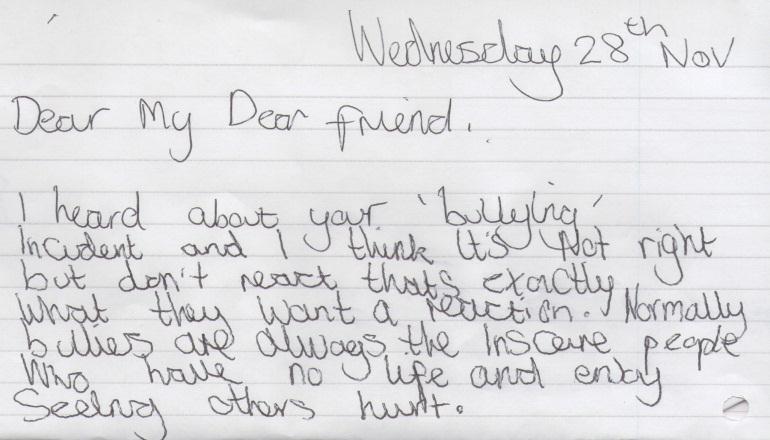

CreateTheChangeToolkit 39
Figure 8: Samples of Reflection Letter About Dealing with Bullies
Execution:Programme Classroom Management
What is Classroom Management?
As a facilitator executing the programme, classroom management skills are crucial towards creating an impactful experience for the participants. Classroom Management is the ability to plan, control and facilitate interaction in the classroom that is appropriate to the activity and promotes learning. It should take into account the different needs and abilities of learners and demonstrate an awareness of equal opportunities.
What is the purpose of Classroom Management?
The purpose of classroom management is:
To manage energy levels.
To ensure appropriate learner participation.
Create working patterns that have a positive impact on learning.

Possible classroom management problems in CTC
Unable To Grab Their Attention: As the programme uses interactive and discussion based activities which encourages discussion and role play, there is the danger of noise levels rising and then the inability to regain control.
Low Participation: Students might not participate because they are shy in a new environment with people that they may not have worked with. They may be uncomfortable doing the drama activities.
Students Not Being Cooperative: As activities encourage them to work together, students may not want to work with someone they do not like or do not know.
Students Taking Their Time: Students get distracted very easily which can slow down the process of the workshop. It is important to keep track on time especially when in a tight schedule.
Students – Talk continuously or show off.

CreateTheChangeToolkit 40
Execution:Programme Classroom Management
Classroom Management Strategies
Sue Cowley’s book “Getting The Buggers To Behave” is a useful book that provides classroom management strategies and techniques that aim towards creating order yet having a relaxed atmosphere in class. In addition it shows how to create an effective learning environment for the students. There are Five Classroom Management Strategies and they are:
1. Learn to “ read” the class
2. Wait for silence
3. Use Repetition
4. Make use of cues
5. Set Targets and Time Limits

Resources:
1. Cowley,S(2008) Getting The Buggers To Behave. ContinuumInternationalPublishingBook:New York
2. Wright,B(2005) There’s No Need To Shout: The Primary Teacher’s Guide To Successful Behaviours Management. NelsonThornes:London
1. Learn to “Read” the class
Reading the class is the judgment of the mood or vibe of the class. Judging the class will help you adapt the class activity to better suit their mood and to maximize motivation in learning. There are ranges of factors that can affect behavior of a class. For example:
1. Time of day – eg. Morning or after lunch.
2. Weather
3. What happened in the previous lesson
4. Teaching space
5. Presence or absence of certain individuals
Techniques Of “Reading” The Class
1. Judge the class before and during the class.
2. Observe the energy of the class.
3. Observe the noise level of the class.
4. Observe the attention span of the class.
In Create The Change
1. First lesson: You will notice that students are sleepy at the beginning of the workshop as it is their first lesson of the day. Due to this, an energizer game that moves the participants will be suitable to energize the participants.
2. Similarly after break or lunch, the students may be restless and tired. Thus, having a focus game and re-capping the activities that were done will be a great way to bring the students to focus back on the programme.

CreateTheChangeToolkit 41
Execution:Programme Classroom Management
Classroom Management Strategies
2. Wait for Silence
In Create The Change, it is important to have everyone’s attention on the facilitator. This is because the facilitator needs to explain the instructions of the activities to the students. Giving the instructions clearly and efficiently will lead the students to do the activity successfully and learn from it. If you do this with the Ambassadors, they will in turn learn to do this with their younger peers.
A facilitator waits for silence by not addressing the students until they are completely silent and fully focused on you. Having a silent attention sends a very clear message: The learning is important and you will not allow it to be jeopardized. If the students are talking over you they will not hear your explanations or instructions. The techniques below are mostly non-verbal as it will lessen the stress of the facilitator and less noise in the classroom
Techniques of Waiting for silence
1. The power of Pause:
When you are in the middle of talking to the class, and individual begins to talk, use a pause to indicate that you are waiting for silence. Have eye contact with the person who is talking. When they stop talking, nod at them to appreciate their behavior to listen.
2. Visual Cues:
Add an interesting visual element to your pauses such as a handheld signboard that has the word ATTENTION on it. Make it eye-catching enough to grab the attention of the students.
3. Non-Verbal Silence Command:
You can clap, even use bell or whistle to grab the attention of the students. We usually put up our hands and wait for everyone to raise their hands. You can instruct the Ambassadors to explain this to the pupils at the start of their workshops.
4. Well-Chosen Phrase
During your facilitation in schools, you will find out that verbal cue for silence will work, although never shout over students. If necessary, repeat the phrase several times over, pausing briefly to gauge the students’ response.

In Create The Change
1. When students are having private conversations, we pause and look at them until we have their attention.
2. Half way through giving instructions, ask the student who was talking to repeat my instructions.
1. Create a signboard that has the word “ATTENTION”.
2. Inform the students the purpose of the board which is to grab the attention of the student after every each activity
1. Hands up technique: Facilitator raises a hand and the students must stop what they are doing, put their hands up and be silent.
Some of the phrases that could be used:
1. Attention here in five,four,three,two,one
2. Eyes on me, Eyes on me.
3. Good listening.
CreateTheChangeToolkit 42
Execution:Programme Classroom Management
Classroom Management Strategies
3. Using Repetition
Much of the time, when we give instructions to the students, we expect it to be heard and understood the first time around. You cannot rely on this and it may lead to unnecessary misunderstanding and confusion. Classrooms can be noisy and confusing places for the students. These could be one of the many reasons why the students do not respond immediately to your directions. Due to this repetition in instructions are important to reinforce behavior or task of the students.
When To Use Repetition?
1. To get a student’s attention before you give an instruction.
In Create The Change
As mentioned in the previous strategy, the use of welldone phrased such as “Eyes On Me” must be use repetitively to ensure that all students’ attention is on the facilitator.
2. When you think your students might not hear your instructions the first time you give them.
This can occur in two situations in CTC:
1. When instructions are complicated, repeating it will allow students to process and understand them better.
2. If instructions are given out during an activity, which is noisy or chaotic, repeating them will ensure that they have listened to the instructions. It is useful to ask them to repeat your instructions as a way to reinforce them.
3. To clarify possible misunderstandings and make your objective perfectly clear.
In CTC, we would repeat the instructions again but exaggerating the important key points of the instructions. We would ask the students to repeat the key points to confirm that they have understood the instructions clearly.

CreateTheChangeToolkit 43
Execution:Programme Classroom Management
Classroom Management Strategies
4. Make Use Of Cues
A lot of facilitators’ stress is caused by fairly low level misbehavior – students calling out answers rather than putting their hands up, students starting an activity before you have finished explaining it. The idea behind using cues is to cue the students into the behavior you do want, rather than letting them behave incorrectly first, then having to tell them off. You can use cues for any behavior that is repeated regularly, and they can be verbal or non-verbal.
When To Use Cues?
1. Answering Questions:
Start any whole-class question with the phrase. “Put your hand up if you can tell me..” By specifying the behavior you want (hands up), you should anticipate and overcome the incorrect response (calling out). These instructions might be gradually abbreviated to ‘Hands Up” or simply ‘Hands!’ Eventually, it might be replaced by the teacher slightly raising a hand if a student goes to call out.
In Create The Change
This is very useful especially when conducting the workshop in a big group. In CTC, the problem that we face are students over talking each other and the same students sharing their ideas. By making them raise their hands before answering, it allows the facilitator to choose students who have not had the opportunity to share their ideas and allow each student to be heard by everyone
2. Giving Instructions
Some keen students will want to do the task before you have even finished giving instructions. Use the phrase “When I say go I want you to start…” Once you have finished your explanation, set the class off to work by saying, “3,2,1 Go!” Again, this can become a shorthand, for instance with the teacher asking “Did I say go?” when a child looks like starting work early.
You will find students to be very enthusiastic to do the task given to them. In CTC, this is disruptive especially when the instructions are not fully explained to them. Take care not to give out pencils, papers while instructions are being given or they will not pay attention.
3.
Listening to each other:
When students are sharing opinions or ideas during a class discussion, there is the possibility that some students may not be paying attention and listening to the discussion. Use the phrase,” everyone, let’s listen to what is being said here.” Once the student has finished sharing, ask the class to repeat what the student has said. This can be shorthand to, ” Everyone let’s listen.”

Letting pupils talk over others or not giving others their full attention can be very disempowering for shy or under confident pupils.
CreateTheChangeToolkit 44
Execution:Programme Classroom Management
Classroom Management Strategies
5. Set Targets and Time Limits
Targets can help you harness your children’s natural sense of competition: perhaps against other students in the class, but more importantly against their own previous levels of achievement. Having a clear amount to achieve, within a set time frame, helps create a sense of urgency and pace to the work. It gives a clear structure – something definite towards which the students can work. Targets can also help your less able children feel a sense of achievement- where a teacher asks the students to brainstorm five words in three minutes, even the least able should be able to complete this task.
How To Set Appropriate Targets?
1. Make sure your targets suit the class: don’t make them too hard to achieve, nor conversely too easy.
2. Keep your targets short and easy to understand.
3. Add visual prompts to aid understanding, for instance holding up a hand to show “3 minutes”.
4. Use language to enhance your students’ motivation levels: words such as ‘competition’ and ‘challenge’.
In Create The Change
In CTC, we use a variety of games, role play, brainstorming and personal reflection to ensure maximum involvement in the workshop when pupils have different working styles.
Time limits are helpful to push students to be focused and think about the information that is given to them.
In addition, it ensures that the workshop has a pace that is always moving and keeping the students continuously occupied at all times.
For example, in a role playing activity, in pairs, they will be given 30 seconds to think of a conflict situation between a mother and daughter. After that, they will be given 2 minutes to improvise the scene.

Tips: Creating a Behaviour Contract
Abehaviorcontractcontainsrulesofbehaviourthatareexpectedbythestudent.Itisnotanyordinary rulebookbecauseitisacontractthathasbeenagreedbybothstudentsandfacilitators.
Havingabehaviourcontracthelpsstudenttounderstandclearlyoftheirexpectedbehaviorinclass.
Atthebeginningoftheprogramme,facilitatorswillhavetoexplainthebenefitsofthecontract,whichis tocreateaimpactfullearningjourneyforeveryone.
ExamplesofrulesinthecontractforCTCare:
1. Tolistenwhenonepersonistalking.
2. Toparticipateinallactivities.
3. Tocooperatewithbothfacilitatorsandfriends.
4. Toalwaysaskwhenindoubt.
5. Torealizethisisa“safeplace”andnottorepeatwhatpupilshavesaidormakefunofthem.

CreateTheChangeToolkit 45
Execution:Programme
The Role of Ambassadors
Who are the Ambassadors?
Ambassadors are students who volunteered or were selected by the school to participate in the Create The Change Programme. They are a group of pumils of mixed abilities, aged 13 and above.
What are the roles and responsibilities of the Ambassadors?
1. To either be actors and create two performances about the theme or be facilitators and deliver the workshop to their younger peers.
2. To be positive role models for their younger peers by projecting good behaviour, showing enthusiasm and interest in the topics.
3. To use the tools and strategies that they have learnt from the programme as a way of assisting their fellow schoolmates in conflict situations in school such as bullying or being discriminated against or when arguments get out of hand.


Possible Challenges
1.SomeAmbassadorsselectedbythe school,inthehopeitwillimprove theirconfidenceandbeaviourmay notbeinterestedintheprogramme.
Solution:Organisationtoworkhard topersonallyinvolveandencourage themorehardtoreachAmbassadors.. Ttoturnthesearoundisvery rewardng.
What are the responsibilities of the organisation towards the Ambassadors?
1. Letter to Ambassadors
This letter is given to each Ambassador before theprogramme.Itcontains:
Thedateandtimingsoftheprogramme
Theoverviewoftheprogramme
Theirroleintheprogramme
Refer to Introduction Pack
2. Training Workshop
On the first day of the programme, the organisation will carry out the same workshop thatthefacilitatorambassadorwillconductfor theiryoungerpeers.Thepurposesare:
ToallowAmbassadorstoexperience,learn andunderstandtheimportance/reason foreachactivity.
Organisationwillberolemodelsfor Ambassadorstofollowthetechniquesof facilitatingtheworkshop.

3. Train Actors Ambassadors
As it could be the first time for some Ambassadors to be acting or creating a performance,itisimportantfororganisationto guide them in developing the performance. Organisation should ensure that the themes of the performance are aimed at realities for targetaudienceandhasanacceptablequality.
Refer to Annex 1-F Introduction for Facilitators
4. Train Facilitators Ambassadors
Organisation should equip Ambassadors with facilitationskillssuchas:
Creating workshopplans/schedule
Givingclearinstructions.
Beingconfidenttalkinginfrontofaclass
Able to communicate and listen to the participantsduringdiscussions.
Able to grab the attention of the participants.
Ableto putacrossthekeymessages.
Abletosupporteachotherintheteam.
Refer to Teacher Pack
CreateTheChangeToolkit 46
Execution:Programme
Working with Teachers
Working with the Teacher Coordinator:
The teacher coordinator plays an important role in making a successful programme. They provide the space, materials and students needed for the programme. In addition, they co-ordinate with other teachers to ensure the programme runs smoothly. Your tasks as the organisation when communicating with the teacher coordinator are:
To give clear instructions of your needs from the school.
To provide the letter for ambassadors.
To provide the letter for all teachers whose pupils will be part of the programme.
To provide all lesson plans that will be used in the programme.
To answers all emails from the school on time and able to be flexible with their needs too.

Working with Teachers Involve In The Programme: Teacher Pack
The teacher coordinator will request assistance from teachers to assist in the running of the programme. The tasks of the teachers for the recipient class are:
To bring the younger peers to the performance area on time.
To bring the younger peers to the designated classrooms for the workshops.
To assist behaviour management of students when Facilitator Ambassadors are conducting the workshops for the younger peers.
To evaluate the workshop conducted by the Facilitator Ambassadors by filling evaluation form given by the Organisation.
To reinforce the Key Messages by using the follow up activities/quizzes that are designed in the Teacher’s Pack
The organization will prepare a Letter to Teachers involved which contain:
Overview of programme
The dates and timings of the programme
The Role of the Teacher
The use of Teacher’s Pack
1. What is a Teacher Pack?
It is a follow up pack designed for teachers to reinforce the key messages of the programme by using the activities that are created in the pack. This pack can be used after the 3 Day Programme.
2. What does the Teacher Pack contain?
Information about the Organisation.
Information about Create The Change.
The different themes that are used in Create the Change.
The follow up activities that can be used after the 3 day programme.
Refer to Teacher Pack.

CreateTheChangeToolkit 47
EvaluationProcess
The Importance of Evaluation
What is Evaluation?
Evaluation is the collection of, analysis and interpretation of information about any aspect of a programme of education or training as part of a recognized process of judging its effectiveness its efficiency and any other outcomes it may have. Evaluation is a process of identifying, analyzing and implementing.
Implement:
Executing improved ideas into the programme to increase the impact and quality of the programme.
Identifying:
Identify the problem in the programme. Is it effecting the outcome that you expect?
Analyzing:
How can we improve the problem?
What can we change in the programme to stop or decrease the problem?






What is the purpose of an evaluation process?
It allows you to monitor the progress of your programme by keeping track of the goals that have been set by the organisation.
It helps you to analyze and find problems that may prevent you from reaching the programme’s objectives.
It helps you assess whether you have realistic expectations of the impact of the programme.




Tip: Creating a Report for Funders
Attheendofeachfundedprogramme, youwillneedtoprovidethefunders withanevaluationreportofthe programme. Theevaluativereport shouldconsistofadetailedprogress descriptionoftheprogrammeandthe variousimpactsandchallengesfaced bytheorganisation.

CreateTheChangeToolkit 48
Implement
Evaluation Process
Identifying Analyzing
EvaluationProcess
Qualitative and Quantitative Evaluation
The first step towards an Evaluation Process is to choose the methods of evaluation. There are two traditional methods which are Qualitative and Quantitative Evaluation. To choose which method is suitable for the programme, consider the following questions:
What is the purpose of the evaluation?
What kind of information would you like to obtain from the evaluation?
What are your resources that can be used to obtain information for the evaluation?
These questions will help you to choose which evaluation method is suitable for the programme.Very often a mixed evaluation method is requied where both qualitative and quantitative data are used.
Qualitative Evaluation:
Definition:
Qualitative evaluation results in the description of problem, behaviours or events. It can provide narrative descriptions of people’s thoughts and opinions about their experiences, attitudes and beliefs. For many individuals, qualitative evaluation is a process of collecting, describing, knowing and interpreting people’s truths.
Qualitative data collection methods:
Open- Ended Questions on a survey or questionnaire
Interviews with people involved in the programme
Observation Note-Taking
Evaluating product produce by participants such as posters, letters and performance.
Advantages of Qualitative
Qualitative Evaluation methods capture more depth and provide insights as to the “why” and “how” of attitudes and behaviours,. They clarify quantitative data and sometimes put it into the context of people’s lives and experiences. This makes qualitative data easier to understand, provides more details and nuances and explains what the programme means to the people involved.

Audiotaping
Video-taping.
Disadvantages of Qualitative
Qualitative data collection methods are time consuming to capture and analyze. This data is more subjective and may be difficult to summarize and compare systematically. It is generally viewed as less reliable because qualitative data is more subjective than quantitative methods. Thus, less credible.
CreateTheChangeToolkit 49
Definition:
EvaluationProcess
Qualitative and Quantitative Evaluation
Quantitative Evaluation:
Quantitative data collection methods consist of counts or frequencies, rates or percentages, or statistics that document the actual behaviors or occurrences. This data can yield representative and generalised information. These methods are usually objective and require the use of standardized measures so that varying perspectives and experiences can fit into a limited number of predetermined response categories. These methods are usually easier to summarize and compare than qualitative methods.
Quantitative data collection methods:
Surveys
Questionnaires that are close ended and measured numerically.
Observation Check list
Advantages of Qualitative
Generally quantitative methods are easy to administer, can include relatively large number of questions, are easier to summarize and are more widely accepted as a form of evidence regarding programme effectiveness.

Disadvantages of Qualitative
Data may not be as rich or as detailed as qualitative methods. Survey/written questionnaires may be difficult for some participants, may not provide all the information needed for interpretations of data findings, and the large amounts of data may require more sophisticated analysis approaches. Resources Ackroyd,J

CreateTheChangeToolkit 50
ResearchMethodologies
(2006)
ForDramaEducatio.TrenthamBooks : USA
EvaluationProcess
Create The Change: Our Process
Mixed Method Evaluation Process
Create The Changeadoopted a mixed method evaluation process. It is a method that uses both quantitative and qualitative in the process. CTC uses a mixed method approach to produce reliable and credible objectives (quantitative) that can then be described or explained in depth by subjective data (qualitative)
We believe that qualitative and quantitative data support each other. For example, there was a high percentage of students who agreed that the strategies that they learnt from the project were useful (Quantitative). This information was supported by the feedback of teachers who reported that students had been using the strategies with their fellow schoolmates (Qualitative). With both sets of information, we can deduce that the strategies in the programme are useful because students are actually using it in school.
Quantitative Data Collection Method
To achieve quantitative data from the programme, we have used a pre-post approach. A pre-post approach is the collection of data before and after the programme. The purpose of this method is to measure the progression and skills that the participants have developed during the programme. Obtaining data at the start of the programme creates a baseline indicator for us to measure the progression of the students at the end of the programme. The method that we used is close ended questionnaires.
Qualitative Data Collection Method
To achieve qualitative data, we analyzed three groups of people; Ambassadors, Younger Peers and Teachers. The purpose of using a qualitative method for these groups of people is to understand the impact of the programme from different perspectives. We were also able to receive constructive and concise feedback, which assisted us in improving the programme. The methods that we used were open ended questionnaires, products of reflections from the students and informal group feedback sessions.

CreateTheChangeToolkit 51
EvaluationProcess
Create The Change: Our Process
3 stage Evaluation Process
Pre


During
•CommunicationSkillQuestionnaire

•Poster/LetterReflections

•Teacher'sObservationFeedback
•AmbassadorOpenEndedFeedback
Post

• StarSheetQuestionnaire

•InformalgroupinterviewwithAmbassadors
•TeacherCoordinatorFeedbackForm

My Communication Skills Form

A Pre- Programme Evaluation is conducted for both Ambassadors and Recipient pupils. They need to complete a MY COMMUNICATION SKILLS form, which is given at the beginning of the workshop. The purpose of the form is to evaluate the students’ communication skills before the programme. This will be the baseline indicator of the students. To focus on the different communication skills that were related to the programme, we used specific statements where the students then had to rate themselves from 1 to 4.
(Refer Annex 13 : My Communication Skills)

CreateTheChangeToolkit 52
Pre- Programme
Figure:CreateTheChangeEvaluationProcess
EvaluationProcess Create The Change: Our Process

During the Programme

Poster and Letter of Reflections
Each workshop contains a reflection activity. It is usually conducted at the end of the workshop. The purposes of a reflection activity are firstly, to reinforce the key messages in the workshop by reflecting the strategies that they have learnt during the workshop. Secondly, it is for us to evaluate their learning during the workshop.
The Posters and Letter of reflection are done individually and are always conducted at a personal level. This method allows us to understand how the programme has connected and is relevant for the students. The data collected will be reliable as it comes personally from the students.
Teacher’s Observation Feedback
As teachers from school will be assisting in the classroom management of the class when Ambassadors are conducting the workshop, they will too observe the workshops and provide feedback to the organisation. They will receive a observation feedback form that will focus on the content of the workshop, the possible impact of the workshop and constructive feedback in improving the programme.
(Refer to Annex 14: Teacher’s Observation Feedback Form)
Ambassador Open Ended Feedback Form
On the third day of the programme, the Ambassadors gather for 15 minutes having delivered the workshops to their younger peers. They will complete a form that will evaluate their progress during the 3 days programme. We decided to have it right after their facilitation as the experience that they had is still fresh in their heads. Thus, they are able to provide a detailed feedback on their experience. The feedback form focuses on their progress in communication skills, their experience as facilitators or actors and the possible impact that they believe they have created on the younger peers.
(Refer to Annex 15: Ambassador Open Ended Feedback Form)

CreateTheChangeToolkit 53
POSTER OF ANTIBULLYING
EvaluationProcess
Create The Change: Our Process

Post-Programme
Star Sheet Questionnaire:
A Follow Up Evaluation Two Weeks After The Execution Of The Programme!
Two weeks after the execution of the programme, the organisation visits the school for a follow up evaluation. We first carry out the evaluation with all the younger students who were involved in the workshop conducted by the Ambassadors. Each student has to complete a Star Sheet Questionnaire. This questionnaire focuses on the areas of communication skills where the students felt they have improved. This allows us to compare findings with the baseline indicator data that we collected before the programme. Comparing the data will allow us to analyse the progress of the students in terms of communication skills. In addition, there is an open-ended question that focuses on how they used their skills. This information will provide us with a better idea of how they can practice the skills from the programme in their daily lives.
(Refer to Annex 16: Star Sheet Evaluation Form)
Informal Group Interview with Ambassadors
The organisations then interview the Ambassadors as a group. We create an informal setting as we want the discussions to be open as possible and give them opportunities to think about the impact it has had on them.The interview focuses on the experience of the ambassadors, their constructive feedback on the programme and their possible change in behaviour in school after the programme. During the interview, the organisation has to take down notes about the discussion. Audio recordings are useful to record the whole interview and not miss out any important information but are sometimes hard to arrange.
Teacher Coordinator Feedback Form
The form is given to the teacher coordinator two weeks before the follow up evaluation. During the two weeks, we would like the teacher to observe the Ambassadors in terms of any changes in behaviour such as confidence, empathy towards friends or closer relationship with their younger peers. These observations will then be placed in the feedback form according to the specific questions. The purpose of this form will allow us to collect qualitative data that will describe the students’ change in behavior from an outside point of view, unlike the informal interview, which just reflects the ambassadors’ opinions.
(Refer to Annex 17: Teacher Coordinator Feedback Form)

CreateTheChangeToolkit 54
LogisticalMatters
Getting CTC Facilitator
Why Do We Need a CTC Facilitator?
The role of the CTC Facilitators is to lead Ambassadors in the workshop and train them to be ambassador facilitators or actors. The workshop leader is responsible for carrying out the activities efficiently and to put across the key messages successfully. It is important to find suitable trained, competent workshop leaders as they will be the representative of the organisation to the school.
Principles Of A CTC Facilitator:
A CTC Facilitator is a guide to help people move through a process together .They are not there to draw out opinions and ideas of the group members.
Making sure everyone feels comfortable participating.
Developing a structure that allows for everyone’s ideas to be heard. Invite them to assess what they are learning as they go.
Making members feel good about their contribution in the workshops. Supporting everyone’s ideas and not criticizing anyone for what they’ve said.
Making sure the group feels a sense of ownership on their ideas.
Ensuring that Ambassadors understand that what they do in the training, they will need to pass on to their younger peers.
Skills Of A CTC Facilitator
Drama Skills: As CTC uses drama as a major component in the programme, drama skills will be essential to ensure the standards of drama teaching and performance during the programme.
Communication skills: These skills are important for them to bring across all the key messages to the participants. Key communication skills are empathy, being confident, speaking clearly and listening. This will also play an important role in creating a close rapport with the participants.
Able to think on their feet: During the programme, unexpected problems or situations may happen. Facilitators should be able to think on their feet and improve or salvage the situations.
Organization Skills: A facilitator should always be prepared before the programme. All materials should be prepared and facilitator should be punctual and well organized – discussing schedule carefully with co-facilitator.

CreateTheChangeToolkit 55
LogisticalMatters Getting CTC Facilitator
Getting Competent Quality CTC Facilitators
1. Employing Experience Facilitators
When hiring faciliators make sure they have experience in the following:
Experience in Teaching Drama.
Experience working with Youth Clubs or in schools
Experience in Conducting Workshops.
Knowledge of putting together workshops.
Selecting facilitators who have the necessary background experience will definitely increase the quality of how the workshops are run. Thus, increasing the impact of the programme to the students.
2. Training Programme for Facilitators
Selecting facilitators for the programme can be a challenge depending on the pool of talent that exists in your community. Due to this, sometimes you may need to hire facilitators who do not have facilitation experience. In this case a training programme will need to be designed for the new inexperienced facilitators. The purpose of this training programme would be:
To train and develop facilitation skills
To educate the facilitators about the programme.
To have the facilitators practice running the workshops with a sample audience
With this, inexperienced facilitators would need to go through a two weeks training programme, depending on how much time is permitted to you. It is recommended to train at least 5 to 10 people before the execution of the overall programme. This will be time effective as it will ensure that you have created a small pool of well trained facilitators you can call on to deliver trainings. Secondly, it will not disrupt your programme once it is up and running and means someone can be take over smoothly and easily.

CreateTheChangeToolkit 56
LogisticalMatters
Checklist of Things To Do
We hope that this Tool Kit has been useful for you to embark on your journey for Create The Change. Now Lets Get Organised! Checklists are always helpful for you to see the things you need to do. And it also feels great to put a tick in the box after finishing a task. Below are the Checklists of Things To Do In Each Stage!
A) Funding
1. Research Funding Bodies
2. Write Proposals for Funding Bodies
B) Publicity Strategy
1. Think of Different Methods of Publicity
2. Create Your Brochures or Posters For Schools
3. Send Out Your Brochures or Posters To Schools
C) Outreach To Schools
1. Find Schools For Create The Change
2. Have the first meeting with the school:
Provide Outreach Pack
Provide Agreement Contract
Decide on Date, Time and Theme of Workshop







CreateTheChangeToolkit 57
LogisticalMatters
Checklist of Things To Do
A) Two Weeks Before The Programme
1. Provide the following documents to the school:
Letters to Ambassadors
Letters to Teachers
Confirmed Workshop Plans
Communication Skills Questionnaire
2. Remind school about your requirements from the school
3. Prepare all materials needed for the Programme.
B) First Two Days of Programme
1. Conduct Workshop With Ambassadors
2. Collect all Communication Skills Form from Ambassadors
3. Coordinate with teachers about the final arrangements during performance day.
C) Last Day of Programme
1. Collect Communication Skills Questionnaire from recipient pupils.
2. Collect Teacher’s Observation Forms.
3. Collect Ambassador’s Evaluation Forms.
4. Give Teacher Coordinator Evaluation Form.
5. Re-confirm follow up Evaluation date.
6. Give Certificates to Ambassadors





CreateTheChangeToolkit 58
LogisticalMatters
Checklist of Things To Do
A) During the two weeks before programme
1. Re-confirm Timing of the Evaluation Process.
2. Provide school the Star- Sheets .Evaluation Form that need to be printed by them for all recipient pupils who received workshops.
B) On Evaluation Day
1. Collect Star Sheets Evaluation form from all recipient pupils.
2. Have an Informal Group interview with Ambassadors.
3. Collect Teacher Coordinator Evaluation Form




CreateTheChangeToolkit 59
Annexes
Annex 1: You Have A Choice Material
a- Plan for the Day
b- Stop, Look and Listen Signs
c- Script
d- “I” vs. “You” Poster
e- “I” vs. “You” Script
f- Introduction for facilitators
Annex 2: Dealing with Bullying Material
a- Script for Ways We Come Across
b- Empathy
c- Introductions for Facilitators
d- Poster
e- Poster
f- Plan for the Day
Annex 3: Evaluations
a- Teacher’s Observation Feedback Form
b- Ambassadors Open Ended Feedback Form
c- Star Sheet Follow Up Evaluation Form
d- Teacher Coordinator Form

CreateTheChangeToolkit

Toolkit
Annex 1
You Have A Choice Material
a- Plan for the Day
b- Stop, Look and Listen Signs
c- Script
d- “I” vs. “You” Poster
e- “I” vs. “You” Script
f- Introduction for facilitators

Create The Change Toolkit
YouHaveAChoiceinHowyouReacttoSituations:YouCanMakeaSituationBetter!
AmbassadorWorkshop
CreateTheChangeProgramme
Title: Session 1 of Create the Change Workshop for Ambassadors. Duration – Whole school day.
Aims:
To explore choices and consequences.
To allow students to explore different conflict resolution strategies.
To enable students to understand they have a choice about whether to react positively or negatively in conflict situations.
To assist students to produce two performances that explore ways of dealing with confict
To train students to be facilitators for the classroom workshops for Year 7s
Target Participants: 20 volunteers from Year 9 (Ambassadors)
*LG = Logistic
09:05
Self Assessment: My Communication Skills (Pre-Evaluation form)
9.15
Name Game
Each ambassador is to fill up the communication form
Each person says their name, favourite food and one communication skill they would like to improve.
To allow participants to reflect on their communication skills. For Peace Child’s evaluation purposes.
To be fun, encourage them to speak out and self assess.
09:20 What makes a good presentation?
Workshop leader lead discussion with ambassadors about different presentation skills.
To allow participants to explore different ways to create a good 7 mins Janne LG: Flip Chart and
Time Activities Descriptions Objectives Duration Facilitator 08.45 Introduction
10mins Rosey 08.55 Ice Breaker Splat Game
10mins
Workshop leader introduces programme and its objectives To introduce Peace Child and the objectives of the programme
To create a space that is fun and comfortable for the participants.
Dan
10mins 5
mins Rosey Dan
09:25
5 Things That Makes Me Angry activity
Workshop leader discuss with them about anger and anger triggers.
Participants get into pairs – each pair will be given a piece A4 paper. They have to draw their hand on the piece of paper.
1. They are to write down their 5 anger triggers. for you
2. Talk about 4 categories of things that make you angry. Things that hurt me, things about me, other people, Things that can’t be helped. Discuss how different anger triggers can fit into categories.
To allow participants to understand personal anger triggers and how to resolve them.
10mins Dan
09.35 1-10 – Body language when getting angry.
In pairs ambassadors count from 1-10 as if in an argument.
Watch some back and talk about body language, voice etc.
Ask ambassadors to think about what the argument might be about, how it started and how it might end.
09.40
Stop Look Listen and Go Forward activity
Lead workshop leader will present the concept of Stop Look Listen and Go Forward through the signage provided.
Rosey and Dan will role play a situation.
Lead workshop leader will ask suggestions and opinions from the Ambassador at each point of Stop, Look Listen and Go Forward.
Maybe repeat the activity, this time, providing
To highlight body language and voice in an argument, and how conflict may be escalated by those involved.
To equip participants with a strategy that could be used in conflict resolution.
5mins Dan
15mins Dan LG: Stop Look Listen and Go Forward signage & situations on paper.
presentation.
Markers
09.55 I vs You Role Play
10:15 Reflection Poster
10:20 Briefing about performance and classroom workshop activities.
If time, discuss possible ideas/scenarios for scenes
two Ambassadors with a Situation to act out.
When, I feel, I would Like.
Workshop leader will present a short scene of using you.
Then show the difference when you use “I” rather than “You.” Will present the negative side of saying you and the negative side of using I.
Students in pairs will try the same scenario and practice.
Ask some pairs to show it to us.
In groups of four, they are to make a educational conflict resolution poster.
They are to use the new strategies that they have learnt and to put it in the poster.
Workshop leader splits the Ambassador into Actors and Facilitators.
Inform them what is going to happen and which room they should be after the break.
Discuss managing a class.
Explain about hot seating.
To show how using “I” statements rather than “you” is a good way to get your feelings across without threatening the other person.
20mins Rosey
LG: Signage for I vs You
To allow participants to reflect on the activities that they have done.
To prepare participants of the upcoming activities after break.
10:50 Break Break Break
11:10 Actors
One workshop leader guides the Actor to create the performance.
To prepare two performances according to the theme of conflict resolution.
10 mins Bobby
LG: 2 to 3 A3 size paper and writing materials
5mins Rosey
Facilitators
One workshop leader guides the Facilitators in training and creating the lesson plan for year 7s.
To be trained as facilitators for the classroom workshop.
Dan
25mins
2 hrs Dan
LG: Papers and Writing materials
Rosey
LG: Papers and Writing materials
14.15 Actors and Facilitators Energizer Game for all Ambassadors.
Actors will present their two performances to the Facilitators.
Facilitators feedback to Actors.
Facilitators will showcase their lesson plan to the Actors.
Actors feedback on Facilitators
14:45 Actors and Facilitators Debriefing
Spend remaining half hour either in separate groups or together.
Workshop debrief the Ambassadors about the second day of workshop
To present their product and provide constructive comments that will be used to improve both performances and facilitation skills.
30mins All
To debrief and reflect about the day 10 mins Rosey
15:15 End End End End
Title: Session 2 of Create the Change Workshop for Ambassadors – Wed. 11.10 -1.10
Aims:
For students to rehearse their performances and practice their facilitation skills.
Duration: 2 hours
Target Participants: 20 volunteers from Year 9 (Ambassadors) Time Activities
Warm Up games and Vocal projection activity
1.10 Lunch Lunch Lunch 45mins
Objectives Duration
Energize
11.10
the ambassadors so that they are 10 mins
11.20 Actors to rehearse scenes
Facilitators to go through lesson plans
prepared for rehearsals.
To polish and tighten performance for assembly. 1hr 25mins
To practice and improve facilitation skills for classroom workshop.
10:50 Break Break 25mins
11.10 00 Continue with scenes and facilitation
12.15 Show scenes. Final notes. Go through workshops
Debriefing about the session and brief about performance day
To allow ambassadors to comment on each other products. 45mins
To inform and prepare ambassadors. 15mins
13.10 End End End
Performanceisat14.10–lasting20mins.
Thursday
Ambassadorswillrunworkshopsthrough2periods
8.50-9,50
9.50-10.50
STOP
There is a problem. What is the story?
LOOK
What is B doing to make me so mad?
LISTEN
To what the other person has to say. Is there a reason for their actions?
GO FORWARD TOGETHER
How can we make the situation better?
I
Stop. Look. Listen
A: I’vebeenwaitingforages.Whattookyousolong?
B.Sorry.Igotuplateandmyalarmdidn’tgooff.
A:Right.You’realwayslate.
B:IsaidIwassorry–what’syourproblem?
A:You’retheonewiththeproblem.YoudothistomeeverysingletimeandI’msickofit.
B: Reacts
Stop. Look . Listen
A: I’vebeenwaitingforages.Whattookyousolong?
B.Sorry.Igotuplateandmyalarmdidn’tgooff.
A:Right.You’realwayslate.
B:IsaidIwassorry–what’syourproblem?
A:You’retheonewiththeproblem.YoudothistomeeverysingletimeandI’msickofit.
B: Reacts
Stop. Look . Listen
A: I’vebeenwaitingforages.Whattookyousolong?
B.Sorry.Igotuplateandmyalarmdidn’tgooff.
A:Right.You’realwayslate.
B:IsaidIwassorry–what’syourproblem?
A:You’retheonewiththeproblem.YoudothistomeeverysingletimeandI’msickofit.
B: Reacts
I rather than YOU
A good “I” statement has 3 parts:
“When”…… this happens
“I feel”…….. and state how you personally feel.
“I would like” ….Suggest how you can both work to resolve the situation to see how you can make it better for next time.
By using “I” rather than you - you can make the situation better.
“I” Vs. “You”
A:Whathaveyougoton?
B: ATShirt–can’tyousee?
A:Butthepointis–it’smyTShirt.Whydoyoualwaystakemythings?
B:Idon’talways…
A:Yes,youdo–yougointomyroomwithoutasking,lookthroughmyclothesandtake whateveryoulike.
B:Wellyoualwaysgetgivennewthings.Iamalwayshavingtowearyouroldcastoffs.
A:Ohcomeon,yougetnewstufftoo.ThereareonlysomethingsthatIgrewoutof.
Butthat’snotthepoint–whydon’tyouaskme?
B:Becauseyouwouldalwayssayno.Youneverwanttoshareanything.
A:That’sbecauseyoualwaysmesseverythingup.
(Discusswherethisconversationisgoing.Willitactuallysolveanything)
Using the “I” Statements.
A: Hi,canwetalkforasecond…
B:Sure–what’sup.
A:WellIcanseeyouarewearing myTShirt.
B:Yes…sorry.
A:It’sjustthatquiteafewthingshavegonemissingfrommyroomrecently. Whenithappens itmakesmereallyannoyedbecauseIfeelthatpeopledon’tcarehowI feel.IwasactuallyplanningtowearthatTshirttogobowlingthisafternoon.
B:I’msorry.Ididn’trealize
A:Wellisthereawaywecouldnotkeepfightingaboutthings?
B:WellthereasonItakethingsisbecauseIfeelyoualwayssay“no”tothingsandyouhave alotmorenewthingsthanIdo.
A:OK.Nexttimeyouwanttoborrowsomethingcomeandaskmeandthenwecandiscussit ok.
B:OK.We’lltryit.
INTRODUCTIONS FOR FACILITATORS
Hi.I’m,……. Andthisis…………………..
We’vebeenlookingatcommunicationskills.Howwerelatetoeachother. Whatmakesusangry andhowwecandealwithouranger. Wearegoingtolookathowwecanmakeasituationbetterratherthanworse.
Weallgetangryfromtimetotime.Betyoudon’tknowasinglepersonwhonevergets angry.Butmanagingyourangerandlearningtoturnaroundasituationisadifferentstory. Thatiswhatwearegoingtolookattoday.
But first…….
we are going to play a game to see how well you focus. You need to watch carefully.
Energiser Game – Splat Play game. After game.
That was to wake you all up.
We are now going to look at Communication Skills. What do you think it means if you have good “Communication skills”(wait for answer)
(Being able to listen/ speak clearly/watch body language etc.)
Wearegoingtopassroundasheettoseehowwellyouthinkyoucommunicate(We want you to write your name and class.
Then give yourself a score – for instance I am a good listener etc .If you think you are good give yourself a 4 or if not very good a 1 or 2. If you have any questions we can come round and help you, but don’t discuss it with your friend. This is just for you). (after gathering in sheets)
Intro:Socommunicationskillsareimportant.Howyounoticethings.Howyourelateto othersandlistentowhattheyaresaying.
Introductions – Now we are going to find out who you all are.
We’d like you to say your name, your favourite food and tell us one communication skill you would like to improve. (repeat what they have said if they are too quiet)
So aswesaidbefore–nearlyeveryonegetsangryatsomepoint.
We aregoingtogiveyoueachasheetofpaper.Wewouldlikeyoutodrawaroundyour handandwritesomethingthatmakesyouangryoneachfinger.Thesesituationsarecalled AngerTriggers.
SoIhaveahand here– read it out.
Mostofthethingsthatmakeusangry/annoyedcanbeputintodifferentcategories.
ThingsThatHurtMe
ThingsaboutMe(personal)
Otherpeople(beingannoying)
Thingsthatcan’tbehelped.
(Aftertheyhavedonetheirhands–ask.)
Canyouputupyourhandandtellussomeofthethingsthatyouhavegot.Youranger triggers.(Discusshowtheyrelatetothedifferentcategories.
Ifsomethingcan’tbehelped(likebeingstuckinaqueueatlunchorhavingtodo homework)there’snorealpointingettingangry.Perhapsthereissomethingyoucandoor someonetospeakto,butbasicallyyoucangetasangryasyoulike,thesituationisnotgoing tochange.Sowhat’sthepointingettingangry?
In this exercise we are going to think about how we use our body language and voices in an argument, and how this can make an argument worse. (Show an example of 1-
10 exercise). Now can you turn to the person next to you and take it in turns counting from 1-10, as if you are having an argument?
Pick some to look at. Ask: How does body language affect the argument for better or worse? How do we use our voice in body language in an argument? How do our voices affect the argument for better or worse?
Wewouldliketoshowyouamethodofdealingwiththenexttimeyougetangry.We wantyoutosaytoyourself:
Stop
Look/Listen
GoForwardTowardtogether.
Stop. Takeadeepbreath.Recognisethereisaproblemandyouaregettingangry.What isthestory?
Look.Atthesituation.Howdoesthismakemefeel?
Listen:Whatistheotherpersonsayingordoing?
GoForward–Howcanweresolvethistogether?
Actors act out scene:
About being late.
When the argument gets heated facilitator says STOP.
Take a deep breath. Think what is going on here.You seem to be getting very angry.
Look: So what is it about B that is making you so mad? What’s your problem? (find out from A)
Listen: OK. Let’s listen to B. What is your issue?
Go Forward together. Ask the class
– How do you think they can resolve the situation. What could you do? (Discuss)
Get A&B to re-run scene using ideas.
Welldone.Sousing
Stop.Look. Listen.Goforwardtogethergivesyouastrategyindealingwithsomeof yourangertriggers.
Anothergoodwayofmakingasituationbetteriscalled“IVersusYou”.Itmeansyou takeresponsibilityforwhathappensratherthanblameitonsomeoneelse.
Inthisscenetryandcounthowmanytimesthefirstpersonspeakingsays“You”. Actors Do scene. About T Shirt!
(if time see if 2 of Yr 7s would like to volunteer to do it)
Questions to ask:
• Wasthepersonwhoseclothesweretakenmakingthesituationbetterorworse?
Nowwearegoingtorunthesceneagainandthistimeinsteadofblamingtheother personwearegoingtotrytoavoidsayingYou.
Soinsteadwesay
When…..
Itmakesmefeel…
Iwouldlike….
•Whatwasdifferentaboutthe2nd scene?Whathappenedthere?
UsingI,ratherthanblamingtheotherpersonfirstisagoodwaytogetacrossyour annoyancewithouttheotherpersongettingmadorangry.
Depending on time – let class try out scenes in pairs.
Do the scenes both ways and then try and get them to say the 2nd scene in their own words.
End of lesson
Let’sjustdoaRe-capofwhatwehavedoneinthissession(Ask)
Howtodealwiththingsthatmakeyouangry..
Stop.Look.Listenandthinkabouthowyoucanresolveit.
Andrememberthatifyouuse“I”ratherthanyouwillmeanyouwillgetintolessarguments.
2nd Session
Ifyourememberwhenwedidthe1-10exercisewelookedatbodylanguage–learningto thinkaboutourownbodylanguageaswellasthesignalsthatotherpeoplearegivingtous.
SomethingelseweneedtoconsiderisEmpathy.
Doesanyoneknowwhatthatmeans?
Puttingyourselfintosomeoneelse’sshoes.
Whatisthedifferencebetweenempathyandsympathy?
(sympathy–justfeelingsorryforthem,pityingthemasopposedtounderstandingwhere theotherpersoniscomingfrom.
Wearenowgoingtogiveyouashortscene.Someofyouwillhavescenesshowingempathy andsomeofyouwillhavesceneswhereyoudon’t/ Intwoscanyouactourthescenes. Thenpickafewtocomeout.
Questions:
Howdiditfeelwhensomeonewasnotlisteningtoyouorshowingempathy?
Howdidthatpersonmakeyoufeelwhentheydidshowempathy. Whatwastheirbodylanguagelike?
Howdidtheyshowtheywerelistening/notlistening?
In groups of 4 we would like you to make a poster about how to deal with conflict. What messages will you give across?
Teacherspart.Inviteteacherstorunhotseating.
OK. Now we ‘re going to look at Hot Seating.
Nowwearegoingtothinkabouttheplaywesawandhowtheycouldhaveacteddifferently. Introduce characters
Invite audience to ask questions
Energiser 7 mins
Quizonanger.
Gothroughbooklets.
Stop.Look.Listen.
Stop. Take a deep breath. Recognise there is a problem and you are getting angry.
What is the story?
Look. At the situation. How does this make me feel?
Listen: To what the other person has to say
Go Forward – How can we resolve this together?
Stop.Look.Listen.
Stop. Take a deep breath. Recognise there is a problem and you are getting angry. What is the story?
Look. At the situation. How does this make me feel?
Listen: To what the other person has to say
Go Forward – How can we resolve this together?

Toolkit
Annex 2
Dealing with Bullying Material
a- Ways We Come Across
b- Empathy
c- Introductions for Facilitators
d- Poster
e- Poster
f- Plan for the Day

Create The Change Toolkit
Passive:
A:Hey,I’mgoingtoMcDonalds,doyouwanttocomewithme?
B:WhywouldIwanttogotoMcDonadswithyou?Idon’tevenwanttobeseentalkingto younow.
A:IjustthoughtIwouldask.
B.Welldon’taskornexttimeyou’llbeinrealtrouble.
A:I’msorry
B:Whyareyoustilltalkingtome,youmuppet!Lookatyou!You’readisgracetothehuman race?
Aggressive
A:Hey,I’mgoingtoMcDonalds,doyouwanttocomewithme?
B:WhywouldIwanttogotoMcDonadswithyou?Idon’tevenwanttobeseentalkingto younow.
A:What’syourproblem?Iwasjustasking.
B.Welldon’taskornexttimeyou’llbeinrealtrouble.
A:I’msorry?
B:Whyareyoustilltalkingtome,youmuppet!Lookatyou!You’readisgracetothehuman race?
Resilient
A:Hey,I’mgoingtoMcDonalds,doyouwanttocomewithme?
B:WhywouldIwanttogotoMcDonadswithyou?Idon’tevenwanttobeseentalkingto younow.
A:IjustthoughtIwouldask.
B.Welldon’taskornexttimeyou’llbeinrealtrouble.
A:I’msorry
B:Whyareyoustilltalkingtome,youmuppet!Lookatyou!You’readisgracetothehuman race?
Empathy
Hownottoshowempathy
Character One
Hey
Character Two
Hi
Character One
What’supwithyou?
Character Two
Nothing..It’sjustthatwhenIwaswalkinghome,Ithoughtsomeonewasfollowingme.Iwalked onforquiteawhileandthenI gotbeaten...
Character One (Interrupting)Ohgood,guesswhatIjustheard?
Character Two
IgotattackedasIwalkedhome...
Character One
Well, Jane’sMumandDadaregoingawaythisweekendandapparentlyeveryoneisgoing roundFridaynight,it’sgoingtobemessy,sorrywhatwereyousaying?
Empathy
Howtoshowempathy
Character One
Hey
Character Two
Hi
Character One
What’supwithyou?
Character Two
Nothing...It’sjustIgotbeaten...
Character One
Itsokyoucantellme
Character Two
WellIgotattackedasIwalkedhome
Character One
Whoby?
Character Two
Whodoyouthink?Thatlotwhoalwaysbeatmeup
Character One
Areyouok?
Character Two
YeahI’mfine
Character One
OkwellI’mgoingtohelpyou,firstwilltalktoyourparentorguardian,thenwewilltalktothe school,ifneededwilltalktothepolice.That’swhatIdidwhentheyusedtobullyme.I’llhelp youthroughthis.
Character One
Thankyou,thismeansalot.
INTRODUCTIONS FOR FACILITATORS
Plan for giving 60 minute lesson
Onboard
Whatkindofbullyinggoeson?
Introduction:
Hi.I’m,……. Andthisis…………………..
We’vebeenlookingatcommunicationskillsandthinkingaboutbullying.In particularways ofreactingtobullying.Wearegoingtobetalkingabout“resilience”.Doesanyoneknow whatthatmeans?
Wait for answers… Learningtoholdyourground. Wewilltalkaboutthatlater.
Wearealsogoingtolookatempathy.
Whoknowswhatthatmeans?
Wait for answers. Puttingyourselfintosomebodyelse’sshoes.
Butfirst…….
wearegoingtoplayagametoseehowwellyoufocus.
Intros 3mins Energiser 7min SelfAssessment 7mins ReactionstoBullying 5mins
Brainstorm Reactions=
Aggressive Resilient Macdonaldscene 5mins Discussbodylanguage 3mins StatusGame 7mins Empathy 5mins Reflection 10mins Conclusion 3mins
Passive
Youneedtowatchcarefully.
Energiser Game – Splat Play game.
After game.
Thatwastowakeyouallup.
Wearenowgoingtolookat CommunicationSkills.Whatdoyouthinkitmeansifyouhavegood“Communication skills”(wait for answer)
(Being able to listen/ speak clearly/watch body language etc.)
Wearegoingtopassroundasheettoseehowwellyouthinkyoucommunicate(We want you to write your name and class.
Then give yourself a score – for instance I am a good listener etc .If you think you are good give yourself a 4 or if not very good a 1 or 2. If you have any questions we can come round and help you, but don’t discuss it with your friend. This is just for you).
(after gathering in sheets)
Socommunicationskillsareimportant.Howyounoticethings.Howyourelatetoothersand listentowhattheyaresaying.
Introductions – Now we are going to find out who you all are. We’dlikeyoutosayyourname,yourfavouritefoodandtellusonecommunicationskillyou wouldliketoimprove.
(repeat what they have said if they are too quiet)
Aswewesaidbeforewearegoingtotalkabout reactionstobullying. Whattypeofbullyingdoyouthinkgoeson?
Getotherfaciliatortowritedowndifferenttypesonboardsuchascyberbullying,physical etc.
Whatdoyouthinkarethe3reactionstobullying?
Brainstorm and then write down
Passive
Aggressive
Resilient
Discuss what each term means.
Then have one of your facilitators act out the script .
After each section discuss what the result of being passive, agressive or resilient would mean.
Make sure you end with “resilient”.
You could see if younger pupils might like to act these out if time allows.
Let us think a bit about body language. Whenyouareresilientwhatisyourbody languagelike? Wait for answers.
Ifyouareaggressive–howisitgoingtolook?Waitforanswers.
Whataboutifyouareresilient–holdingyourground?Waitforanswers
We are now going to play a game about confidence levels.
Wewantyoutopairupandselectasituationfromthetitleswrittenontheboard.You caneitherbe
Shopkeeperandcustomer
Teacherandpupil
Employerandemployee
Footballcoachandplayer.
Sodecidewhichyouwanttobe.
Nowwearegoingtocomearoundandgiveyoueachaconfidencelevel.Oneistheleast confident.10isthemost.
Younowneedtoimproviseashortsceneplayingyourroleandshowingyourlevelof confidence.Don’ttellanyonewhatyourlevelis.Notevenyourpartner. Watch scenes and then select a few.
Once they have done scene invite rest of pupils to guess which level they were.
Whydidyouthinkthatxwasthatlevel?
Whatwastheirbodylanguagelike?
Doyouneedtobeloudtobeconfidentorcanyoubequietlyconfident,withoutbeing pushedabout?
Watchingourownandotherpeoples’bodylanguageisimportantNowwearegoingto talkaboutempathy.Doesanyonerememberwhatthatmeans?Wait for answer!
Now we are going to give each pair a scene to work on – either showing empathy or not showing empathy.
Give them 5 mins to practice and then invite a few pairs . Start off with not showing empathy and then ask B who was being bullied how she felt telling her story. Then show the scene showing empathy and ask them questions like: Whatdidyoufeellikewhenyouweretellingyourstory?
Whatwasyourbodylanguagelike?
Howdidtheyshowtheywerelistening/notlisteningtoyou?
Everybodylikestobelistenedto.Showingempathyisimportant. Nowwewouldlikeyoutoeachwriteashortlettertoanimaginarypersonbeingbullied oritcouldbesomeoneinthesceneswesawinassemblyandgivethemadviceonhow todealwiththesituation.
Give them 5 mins and then share some of the examples.
Conclusion:
Sothankyouforbeingagreatclass.Rememberyoucanhelppeopleifyoulookoutfor signsastowhatisgoingon–showingempathytopeopleandnoticingtheirbody language.Beingresilientandholdingyourgroundmeansthatthebullywillbeless inclinedtokeeponbullyingthaniftheygetapassiveoraggressivekindofreaction. Rememberifyouseebullyinggoingontotellsomeone.
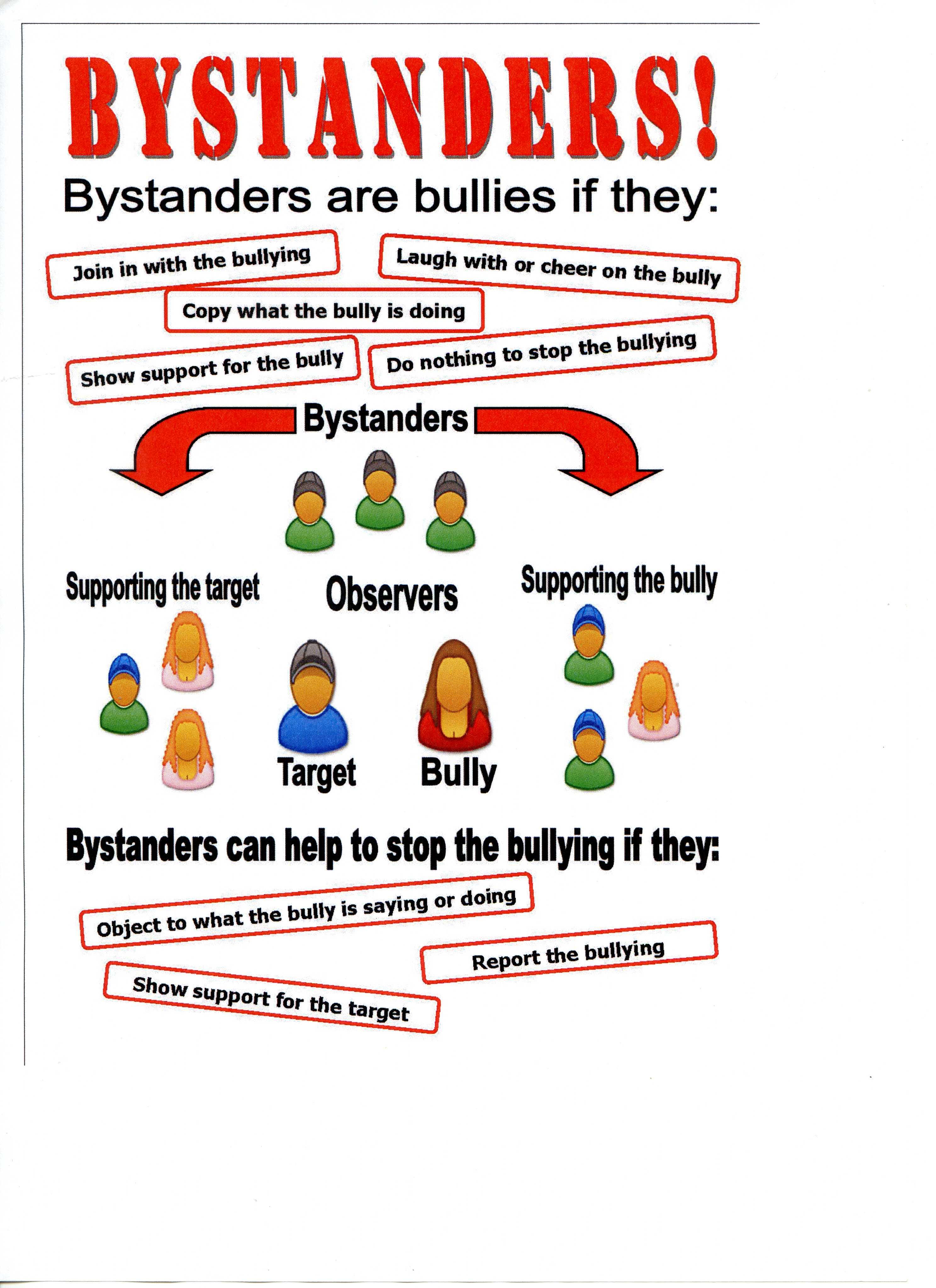



Create The Change Toolkit Toolkit Annex 3 Evaluations a- My Communication Skills b- Teacher’s Observation Feedback Form c- Ambassadors Open Ended Feedback Form d- Star Sheet Follow Up Evaluation Form e- Teacher Coordinator Form
Name:
Date:
Ambassador Programme
My Communication Skills
Class:
School:

Below are eight statements, which may or may not be true. Using the 1-4 scale below, please indicate your agreement with each item by placing the appropriate number on the following line. Try to be open and honest.
1 Not True
2 Sometimes True
3 Usually True
4 Exactly True
1. I am confident talking to people and am able to express my ideas.
2. I am a good listener.
3. I am able to stand up for others when I think it’s right.
4. I find it difficult to talk to people who have different views to my own.
5. I am able to stand up for myself.
6. I am good at understanding how others feel.
7. I notice other people’s body language and my own.
8. I recognise that the way I react to things can affect a situation.





Communication Skills I would like to develop are:

education@peacechild.org
Tel 01763 274459 or Peace Child International
The White House, 46 High Street, Buntingford, SG9 9AH Herts, United Kingdom
Name: Class School
1. What do you think the children learned most from the workshop?
2. Do you think they will be able to continue/build on what they have learned?
3. Do you think having older pupils deliver workshops is effective?
4. Is there any advice you would give them?
5. Do you think you will be able to use any of the materials provided in the future?
Review Sheet for
Ambassadors following presentations
Name: ……………………………………………………………..; Date: …… / …… / 2011;
1. What new skills do you think you have developed through this programme?
Please circle which of the following skills you have developed?
Empathy. Body language. Building resilience. Learning to listen more. Standing up for others. Anger management.
Getting along with people who have different ideas than your own.
Confidence. Expressing myself. Communication skills.
Any Extra skills?
2. What did you like about giving presentations/workshops?
What didn’t you like?
3. What impact do you think you had on the pupils to whom you gave the workshop?
4. Can you think of occasions when you will use what you have learnt?
5. Do you have any recommendations for Peace Child when working with other groups?
……………………………………………………………………………………………… …………………………………………………………………………………………..
…………………………………..…………………………………………………………..
…………………………………..…………………………………………………………..
…………………………………..………………………………………………………….. …………………………………..…………………………………………………………..
…………………………………..………………………………………………………….. …………………………………..…………………………………………………………..
…………………………………..………………………………………………………….. …………………………………..………………………………………………………….
Name:
School:
Ambassador Programme
Matching - My Communication Skills
Date:
Class:
Draw a line to match the words in the left with statements on the right.
Word Bank
Empathy
Think before I act
Discussing calmly
Body language
Confidence
Anger management
Bullying
Confrontation
Intolerance
Expressing myself
Standing up for others
Resilience
Listening
Reaching out to others
Statements

1. I am confident talking to people and am able to express my ideas.
2. I am a good listener.
3. I am able to stand up for others when I think its right.
4. I find it difficult to talk to people who have different views to my own.
5. I am able to stand up for myself.
6. I am good at understanding how others feel.
7. I notice other body language and my own.
8. I recognize that the way I react to things can affect a situation.
Page 1
Name:
Date:
Ambassador Programme
3 Things I learned
Class:
School:
1. Circle the three words from the word bank below that you feel you most improved your skills in.
Empathy Standing up for others

Discussing calmly Resilience Expressing myself Confidence
Think before I act Body language Anger management Listening
2. For each star, fill in one of the skills you circled.
Reaching out to others
3. Using a pencil crayon, colour in the point of the star that represents how much you feel you improved that skill.
On a scale of 1-4 I feel I improved my skills in…
1 Not true Skill I feel I improved: 2 Somewhat true 3 Mostly true 4 Exactly true 1 Not true Skill I feel I improved: 2 Somewhat true 3 Mostly true 4 Exactly true 1 Not true Skill I feel I improved: 2 Somewhat true 3 Mostly true 4 Exactly true
If you feel you have improved one or more of these skills can you give us an example of how you have used a particular skill. (e.g., At home or school with your friends or classmates).

education@peacechild.org
Tel 01763 274459 or Peace Child International
Evaluation for Coordinators of the programme
Name: Class
School:
Part 1 to involve any pupils who were selected for specific needs
1) How many of those pupils selected for this programme would you describe as “not achieving their full potential”?
First names:
2) What were the skills that they lacked and the reasons for encouraging them to take part in the programme?
3) Would any of the following be applicable to your students?
Increased their leadership skills Yes/No
Increased their confidence Yes/No
Developed presentation skills Yes/No
They felt their opinions mattered and felt respected Yes/No
Do you feel that for these pupils who are not normally active in the schools community it has it helped them to become any more engaged Yes/No
4). Do you think they will be able to use /build on what they have learned? If so – how?
3) Can you give any examples where you have noticed any change in pupils?
4 Do you think that the information provided will be useful for teachers to use ?
5. Would you be interested in running the same programme with another year group next year or embedding it in part of the school programme?




 ByNOORIZZATYBINTEISHAK ProjectCoordinatorof CreatetheChangeProgramme
EditedbyRoseySimondsand VirginiaPontarolo
ByNOORIZZATYBINTEISHAK ProjectCoordinatorof CreatetheChangeProgramme
EditedbyRoseySimondsand VirginiaPontarolo































































































